#and my theme is the rise in theatricality through painting
Text
Review: Chaidura’s blend of eccentric hyper-pop and metal in new single ‘The Light’ is an incomparable taste of unique artistry
London-based alternative rock artist Chaidura is known for his staple dramatic and theatrical sound with heavy undertones. Slowly growing a dedicated fanbase, his music defies categorisation and captivates listeners with its distinctiveness. Perfect for fans of X Japan, Bring Me The Horizon, While She Sleeps and more, his newest offering ‘The Light’ is sure to be a breath of fresh air in what it has to deliver.
Everything about ‘The Light’ is experimentally diverse, fluctuating right from the beginning with an air of jazz and orchestral vocals, shifting into hyperpop electronics quickly after. Unafraid to change and instead keeps things unpredictable, Chaidura thrives in this bold and bombastic sound, in many ways the “marmite” of sound in that whether you love or hate it you’re likely to immediately feel strongly, unable to forget about the experience. From scattered electronics and pulsating drum beats, the soundscape is almost unhinged in everything it throws your way, dancing through this momentum with continued saxophone and female vocals absolutely smothered in effects. Things find a point of calm as the first verse opens up, Chaidura singing atop quickly pounding drum beats and a cascading night-club-esque scattering of theatrics with a smooth performance doused in light vocal effects of his own taking centre stage. As some lines gleam with a hint of human strain, Chaidura’s entire experience falls between captivating and catchy while personal and emotive too. This is only further built upon as things rise and fall moving forwards, taking a moment to breathe before the choruses explosion. Powered by Chaidura’s leading vocals that are pushed to the max like an over exaggerated anime intro, this swift burst of technicolour cascades through more colourful electronics, backing female vocal rises, even greater pulsing beats and more all at once.
Just as you think you know what you’ve got yourself in for, the bridge turns into the most unexpectedly metal breakdown, moulding together genres that utterly shouldn’t fit by definition and yet transition like they were made to. With continued electronics pushed as loud as fast as possible, this ground-shattering breakdown forces harshly screamed vocals, thunderous drum beats and aggressively gritty electric guitar into one eccentric package. It’s kind of hard to keep up with Chaidura, but frankly you never really want to, being dragged along at full force whichever way he’s set to unexpectedly pull you - and even if it’s far from what you’d usually listen to, it’s somehow too captivating to stop.
The narrative is just as profoundly captivating, telling a heartfelt confession that yearns for completeness and assistance along the journey. Painting the picture of a lost soul that’s universally relatable to all, Chaidura sings of a desperation, struggling through self-discomfort and crying out for someone to rescue them. Through lines like ‘my past is haunting my mind’, Chaidura sets up a safe place for people to share their troubles, an embrace when loneliness may otherwise take over and an acceptance these feelings are shared by many. Further lyrics like ‘feels like I’m dying to be alive’ accentuate this theme, being beaten down by life itself in a way that’s hard to persevere. The lighter sound almost offers hope in itself though, an undertone of strength and confidence that you can pull through even when consumed by a reality that declares otherwise. The multi-faceted line ‘I want to give up on myself, I want to find my paradise’ almost seems to show determination though, eager to make peace with the world’s torments - unless of course indicative of a darker sense of paradise in the afterlife. Either way, this pained journey is one that’s authentic and unfortunately all-too relatable for many, capturing unfiltered thoughts in a sound just as loud and unapologetic.
Chaidura continues to add, "The lyrics are my vulnerable moments expressed. This song is my way of encouraging empathy, urging fans to be mindful of their mental wellbeing and embrace the notion that seeking help is not a weakness. Visually, I've adopted the persona of a Pierrot, a sad clown, symbolising misfits and those who feel different.”
Check out ‘The Light’ for yourself here to understand what it is that sets Chaidura apart.
Written by: Tatiana Whybrow
Photo Credits: Unknown
// This coverage was supported and created via Musosoup, #SustainableCurator.
0 notes
Video
youtube
With no time to waste, we have a tremendous news update on Dragon Age 4’s current iteration known as “Morrison”, as many development secrets were revealed in BioWare’s brand-new hardcover book of “Stories and Secrets from 25 Years of Game Development.”
A lot of the questions that we’ve all been asking over the past few years, finally have an answer, all thanks to this book. I will be delving into all of the Dragon Age 4-related content in this book; however, I wholeheartedly advise you pick up the book for yourself because it is filled to the brim with insights, information and behind-the-scenes reveals on every BioWare game to this date.
It’s full of so many captivating, inspiring and amazing stories that showcase BioWare’s incredible journey over the past 25 years.
In any regard, we’ve got a lot to get into, so leaving no stone unturned, we’ve got some updates regarding Dragon Age: Morrison, the current-rebooted project code name of the next Dragon Age game.
Morrison:
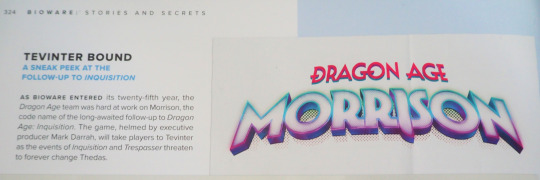
Along with this amazing retro-styled font of Morrison’s code name - that I’m totally going to use in future videos and thumbnails - we actually have a small plot synopsis on this working title.
It reads as followed: “Tevinter Bound – a sneak peek at the follow-up to Inquisition.”
“As BioWare entered its twenty-fifth year, the Dragon Age team was hard at work on Morrison, the code name of the long-awaited follow-up to Dragon Age: Inquisition. The game, helmed by executive producer Mark Darrah, will take players to Tevinter as events of Inquisition and Trespasser threaten to forever change Thedas.”
We’re going to Tevinter! Of course, we already knew that based on Trespasser’s ending, Tevinter Nights, and the developers already hinting that, but it is still very nice to see hear that in a plot outline.
In addition, the most interesting factor about this synopsis, is that for the first time BioWare have confirmed that “Morrison” is indeed the code name for the current Dragon Age project, which outrightly confirms that Jason Scheirer’s Kotaku article on “The Past & Present of Dragon Age 4” carries merit and truth to it, meaning that we can indeed trust the entire contents of Jason’s article.
Regardless, sticking with the 80’s retro theme, BioWare staff have themed shirts for the project, and they look absolutely amazing. Please, BioWare Gear Store release these one day, if at all possible, these designs are so good!
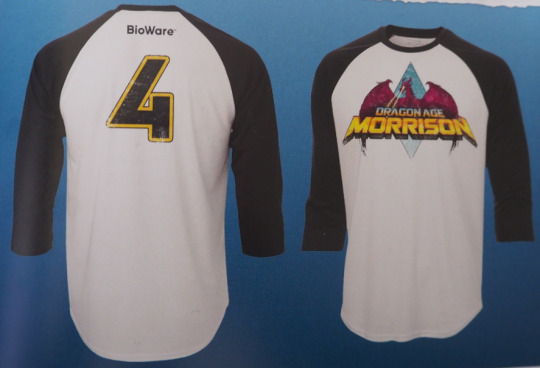
The book then goes on to show very familiar concept art that was showcased within the Gamescom behind-the-scenes trailer, however, this time, we have actual descriptions on each of the art pieces, and what they’re portraying. So, we don’t need to spend another 40 minutes speculating about what the pieces could show.

The underwater shot which we assumed to be Isabela accompanied by what looks like Dorian with a sword, an undead and a female dwarf, appears to showcase the Lords of Fortune, a newly-introduced faction within Tevinter Nights.
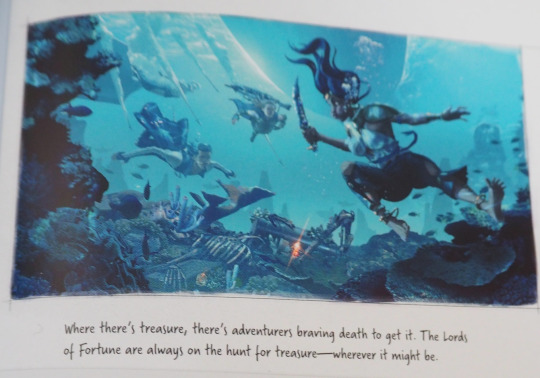
The synopsis says:
“Where there’s treasure, there’s adventurers braving death to get it. The Lords of Fortune are always on the hunt for treasure-wherever it may be.”

The next shot, which I speculated it as Tevinter’s capital city Minrathous, has a synopsis that says:
“The glittering hubs of Thedas are beacons of civilization and bulwarks against the night.”
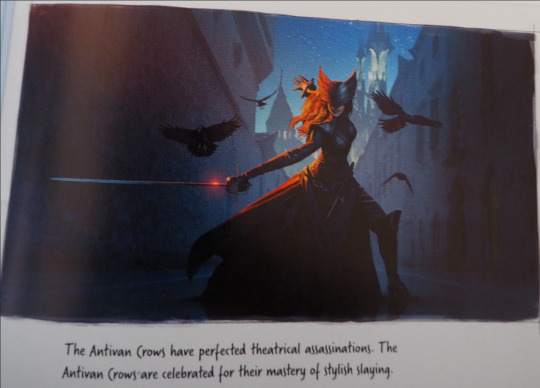
Following that, we have the mysterious Antivan Crow lady concept art with the synopsis:
“The Antivan Crows have perfected theatrical assassinations. The Antivan Crows are celebrated for their mastery of stylish slaying.”
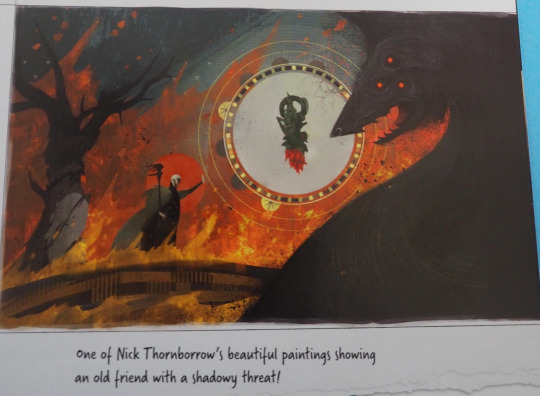
And then we have a most recognisable mural, one that many of us have spent way too long staring at, tinfoiling over its endless possibilities. The synopsis of The Dread Wolf Rises concept piece says:
“One of Nick Thornborrow’s beautiful paintings showing an old friend with a shadowy threat!”
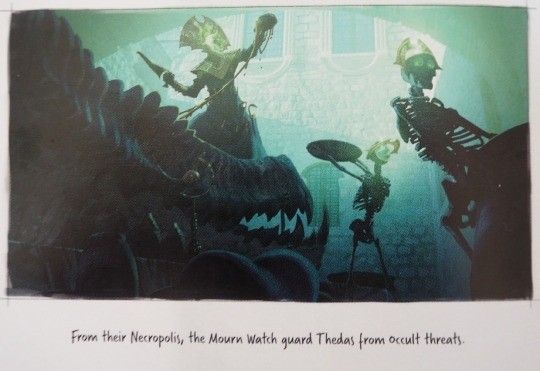
Following that, we have Nevarra’s undead operating on a dragon, with the synopsis saying:
“From their Necropolis, the Mourn Watch guard Thedas from occult threats”

And then we have – hold on, what’s this, a new piece of concept art? Roll on the tinfoil, I’ll read the synopsis first and then we can go from there, as it states:
“The Deep Roads teem with evils both new and old, known and unknowable.”
I won’t spend ages delving into a single piece of concept art, but we can see the Deep Roads with plenty of light coming from the surface. It’s a beautiful shot, that I’m sure is building a mood for potential locations in the next game.

The final concept art piece shown is one from the trailer, however, it’s not cut-off anymore. When it once looked like an evil Cetus, it now reveals something even more wicked than a sea dragon... A figure with multiple arms, red eyes, a curved headpiece, holding a spear. Is this an ancient God? Could it be Ghilan’nain? A Lovecraftian sea-hybrid-monster? Or is it just a crazy idea thrown together by a concept artist, because why not?
The synopsis is the most intriguing and provides a further context for the next Dragon Age game:
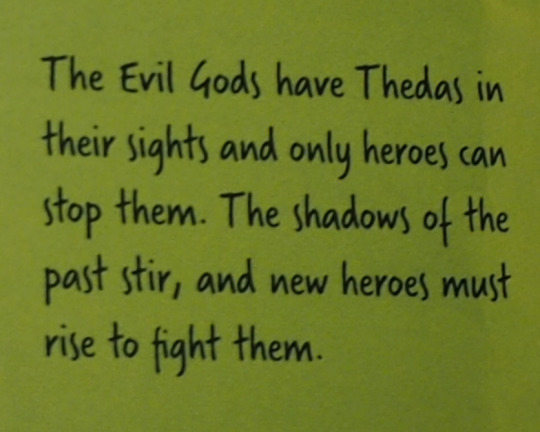
“The Evil Gods have Thedas in their sights and only heroes can stop them. The shadows of the past stir, and new heroes must rise to fight them.”
There are many “gods” in Dragon Age, the Old Gods, the Elven Gods, the Maker, the Titans, etc. You could certainly consider each of them to be evil too, but on a whim, with the whole “shadows of the past stir.” I’m sure this synopsis is referring to the Elven Gods, given Solas’s scheme that will return the Evanuris to Thedas once more.
Taking my tinfoil hat off for a moment, this book expertly describes concept art stages relating to BioWare, and I need to touch on what exactly these pieces could mean going forward, because they most certainly could just be conceptual drawings without much context for the next game.
The book quotes Dragon Age 2’s development regarding concept art, saying:
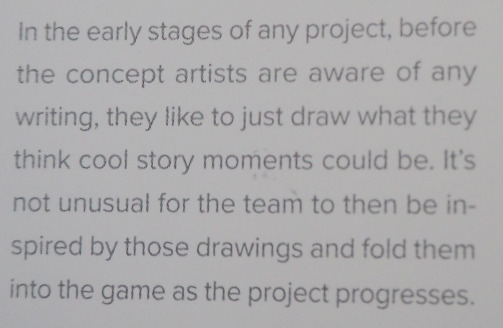
“In the early stages of any project, before the concept artists are aware of any writing, they like to just draw what they think cool story moments could be. It’s not unusual for the team to then be inspired by those drawings and fold them into the game as the project progresses.”
And, even further than that, Matt Rhodes, who is the Art Director of the next Dragon Age spoke a few words regarding Dragon Age: Inquisition’s conceptual art stages:

“As multiple teams worked on their corners of Inquisition, lead concept artist Matt Rhodes spent weeks creating images to help solidify and drive a vision of what the game could be.”
“It was partly to encourage and remind myself of what the potential of this project could be,” Matt says. “We all imagine the finished game. I wanted to get that on paper, to remind everyone we are making something that could be pretty cool.”
So, while we’re all so excited to see these amazing concept designs and imagery, and we love to correlate it all to the next game, remember that these designs are very early work building a vision for the next game, they’re just being used to represent what idealistically the developers would like the game to end up like, or what insane ideas the concept artists have for the game.
Many of these ideas won’t turn out in the final product, but it’s still so nice to see this work already.
Wolf Rook Book:
Moving on, we can put an end to a five-year mystery, we finally have answers on that enigmatic red “Wolf-Rook" book that Mark Darrah has teased for half a decade.

One of my first ever videos on this channel was delving into the early pages of this book, back then I had a hunch that this book was the next Dragon Age game’s early concepts and designs, like a shiny development doc for the team.
And I was on the right tracks, as followed:
“The book was an internal guide for developer and publisher eyes only that summarized the vision for Dragon Age: Inquisition’s follow-up, a project code-named Joplin. The Joplin project has since been revised to such an extent that its code name changed to Morrison, but the red book still contains plenty of ideas likely to appear in the next Dragon Age. While most pages remain highly classified, here are a few Mark said we can publish.”
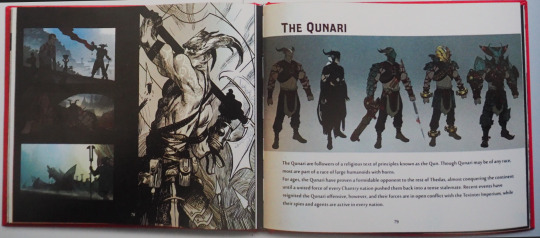
There’s a small description of The Qunari with some other concept shots, the paragraph reads as followed:
“The Qunari are followers of a religious text of principles known as the Qun. Though Qunari may be of any race, most are part of a race of large humanoids with horns.”
“For ages the Qunari have proven a formidable opponent to the rest of Thedas, almost conquering the continent until a united force of every Chantry nation pushed them back into a tense stalemate. Recent events have reignited the Qunari offensive, however, and their forces are in open conflict with the Tevinter Imperium, while their spies and agents are active in every nation.”

And at the bottom we have a Creatures double-spread page with different concepts very similar to those seen in Inquisition, the paragraph reads as followed:
“Animals, monsters and misplaced magical experiments: creatures stir apart from the conflicts and machinations flowing across the continent. Creatures range from the lowly nug up to the ultimate apex predator, the dragon. The next Dragon Age will feature our widest and most varied set of creatures to date. While often quite simple in implementation, creatures provide variety through differentiated animation and appearance.”
So, “Wolf-Rook” is still relevant, somewhat confirming that the work that went into Joplin, may cross over into Morrison, which is very exciting because Joplin’s vision for a Dragon Age title sounded amazing, so to hear aspects of that work pouring into this new project is absolutely fabulous. I had a hunch that the red book was still valuable to the current project, because we’ve seen a lot of “Wolf-Rook” teased this year, Mark Darrah has not stopped showing off his stash of red books. So, I’m very glad it’s here to stay for the current iteration.
Dragon Age Week:
Next up, we have an update to a story I talked about in March of this year, Mark Darrah teased a picture of his laptop with the BioWare Slack server shown at the bottom of his screen.

One of the channel-titles within the server was one by the name of “DA Week”, and thanks to this book, we know what “Dragon Age Week” actually is:
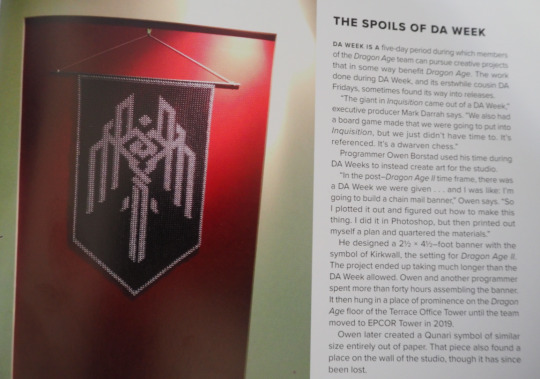
“Dragon Age Week is a five-day period during which members of the Dragon Age team can pursue creative projects that in some way benefit Dragon Age. The work done during DA Week, and its erstwhile cousin DA Fridays, sometimes found its way into releases.”
“The giants in Inquisition came out of a Dragon Age Week,” executive producer Mark Darrah says. “We also had a board game made that we were going to put into Inquisition, but we just didn’t have time to. It’s referenced. It’s a dwarven chess.”
So, I do wonder what kind of ideas have come out of Dragon Age Week recently that has then ended up in the next Dragon Age. Hopefully, one day we’ll have a new book that tells us Dragon Age 4’s secrets and we can visit this topic.
New BioWare Vision:
Moving on to the final major update, thanks to this book, we have a greater understanding about the vision BioWare have going forward. According to General Manager, Casey Hudson and Dragon Age, Narrative Director, John Epler.
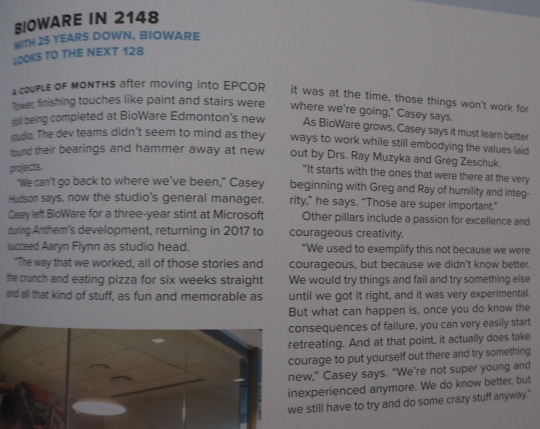
Casey Hudson spoke on the “old” BioWare and how their changing paths to a “newer” BioWare:
“We can’t go back to where we’ve been,” Casey Hudson says, now the studio’s general manager. “The way that we worked, all of those stories and the crunch and eating pizza for six weeks straight and all that kind of stuff, as fun and memorable as it was at the time, those things won’t work for where we’re going.”
As BioWare grows, Casey says it must learn better ways to work while still embodying the values laid out by Drs. Ray Muzyka and Greg Zeschuk.
“It starts with the ones that were there at the very beginning with Greg and Ray of humility and integrity,” he says, “Those are super important.”
Other pillars include a passion for excellence and courageous creativity.
“We used to exemplify this not because we were courageous, but because we didn’t know better. We would try things and fail and try something else until we got it right, and it was very experimental. But what can happen is, once you do know the consequences of failure, you can very easily start retreating. And at that point, it actually does take courage to put yourself out there and try something new.”
Casey says. “We’re not super young and inexperienced anymore. We do know better, but we still have to try and do some crazy stuff anyway.”
John Epler shared on the change going on within BioWare:

“I am excited for what the future holds. I think BioWare is changing. I think we’re at a crossroads where we can either accept that and move into the new BioWare, or we can try to cling to the past. We have to be respectful of our origins without being constrained by them. It’s an exciting time and I’m really looking forward to what the next five years brings.”
“’I’m one of those people who is probably going to be here until they have to literally wheel my desiccated corpse out of the building, because I love working here and I love the people I work with and I love getting to come into work every day to have long, detailed conversations about how eluvians work.”
All in all, I’m incredibly excited and optimistic for BioWare’s future, they’re aware of their flaws, while knowing what makes them great. They seek to humble themselves, while changing direction, they want to avoid crunch while being experimental. I think we’re going to see the company bloom when they inevitably release the next Dragon Age, and I am totally here for that.
Dragon Age Day
Before I leave you, Dragon Age Day is quickly approaching, and it seems BioWare have plans this year. EA Community Manager, Jay Ingram tweeted about fans asking questions for the Dragon Age team, in prep for plans on Dragon Age Day. I’ll link the tweet down below, so you can ask as many questions as you’d like! It seems that BioWare may stream on Dragon Age Day, so do watch out for that, and give them a follow on their Twitch, also linked down below:
https://twitter.com/JayKingIngram/status/1325197450907275264
https://www.twitch.tv/bioware
Regardless, this is where we part ways. There was so much that this book uncovered, I highly recommended picking It up for yourself, it’s truly worth it to any BioWare fan. There was also some future Mass Effect stuff, but I’m saving that for a future video that I’ll do at the start of the new year. And I most likely will do future videos on other topics revealed in this book.
#dragon age 4 news#dragon age news#biowar#bioware 25 years#dragon age update#morrison#joplin#wolf rook book#mark darrah red book#mark darrah slack server#dragon age week#next dragon age#concept art#dragon age concept art#dragon age 4#dragon age 4 concept art#the dread wolf rises#da#da news#tevinter bound#imperium#tevinter#thedas
36 notes
·
View notes
Text
Riot Fest 2021: 9/16-9/19, Douglass Park
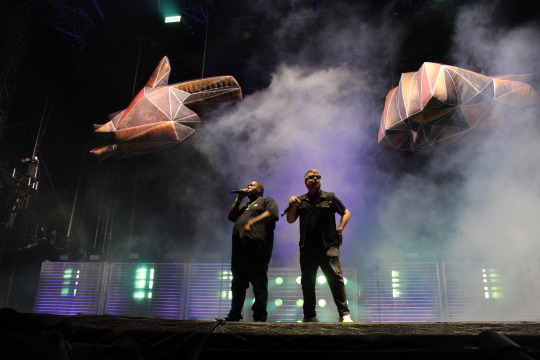
BY JORDAN MAINZER
Much like Pitchfork Music Festival earlier this month, this past weekend’s Riot Fest felt relatively normal. Arriving at Douglas Park every day, you were greeted by the usual deluge of attendees in Misfits t-shirts and dyed hair, the sound of faint screams and breakneck guitars and drums emanating from nearby stages. The abnormal aspects of the fest, at least as compared to previous incarnations, we’re already used to by now from 2021 shows: To get in, you had to show proof of vaccination and/or a negative test no older than 48 hours, which means that unvaxxed 4-day attendees had to get multiple tests. Props to the always awesome staff at Riot Fest for actually checking the cards against the names on government-issued IDs.
For a festival that dealt with a plethora of last-minute changes due to bands dropping out because of COVID-19 caution (Nine Inch Nails, Pixies, Dinosaur Jr.) or other reasons (Faith No More/Mr. Bungle because of concerns around Mike Patton’s well-being), there were very few bumps in the road. Whether Riot Fest had bands like Slipknot, Anthrax, or Rise Against in their back pocket as replacements or not, it very much felt like who we saw Thursday-Sunday was always supposed to be the lineup, even when laying your eyes on countless “Death to the Pixies” shirts. Sure, one of the fest’s main gimmicks--peeling back the label on Goose Island’s Riot Fest Sucks Pale Ale to reveal the schedule--was out of date with inaccurate set times and bands, and it still would have been so had Faith No More and Mr. Bungle stayed, since Fucked Up had to drop out last minute due to border issues. But the festival, as always, rolled with the punches.
The sets themselves offered the circle pit and crowdsurfing-inducing punk and metal you’re used to, with a few genre outliers. For so many bands of all styles, Riot Fest represented their first live show in years, and a few acts knew the exact number of days since their last show. For every single set, the catharsis in the crowd and on stage was palpable, not exactly anger, or elation, but pure release.
Here were our favorite sets of the festival, in chronological order.
WDRL
Last October, WDRL (which, amazingly, stands for We Don’t Ride Llamas) announced themselves with a Tweet: “y’all been looking for an alt black band,, well here you go”. A band of Gen Z siblings, Chase (lead guitar), Max (lead vocals), Blake (drums), and Kit Mitchell (bass guitar), WDRL is aware, much like Meet Me @ The Altar (who, despite my hyping, I couldn’t make it in time to see) that they’re one of too few bands of POCs in the Riot Fest-adjacent scene. Their set, one of the very first of the weekend during Thursday’s pre-party, showed them leading by example, the type of band to inspire potentially discouraged Black and brown folks to start punk bands. Max is a terrific vocalist, able to scream over post-punk, scat over funk, and coo over slow, soulful R&B swayers with the same ease. The rest of the band was equally versatile, able to pivot on a dime from scuzzy rock to hip hop to twinkling dream pop. Bonus points for covering Splendora’s “You’re Standing On My Neck”, aka the Daria theme song.

Joyce Manor
Joyce Manor’s self-titled debut is classic. The best part of it as an album play-through at a festival? It’s so short that you can hear it and you’ll still have half a set for other favorites. So while the bouncy “Orange Julius”", “Ashtray Petting Zoo”, and ultimate singalong “Constant Headache” were set highlights, the Torrance, CA band was able to burn through lots from Never Hungover Again, Cody, Million Dollars to Kill Me, and their rarities collection Songs From Northern Torrance. Apart from not playing anything from Of All Things I Will Soon Grow Tired (seriously, am I the only one who loves that record?), Joyce Manor were stellar, from the undeniable hooks of “Heart Tattoo” to the churning power chords of “Catalina Fight Song”. After playing “Christmas Card”, Johnson and company gave one final nod to the original fest cancellation, My Chemical Romance, who were slated to headline 2020, then 2021, and now 2022. If you ever wondered what it would sound like hearing a concise punk band like Joyce Manor take on the bombast of “Helena”, you found out. Hey, it was actually pretty good!
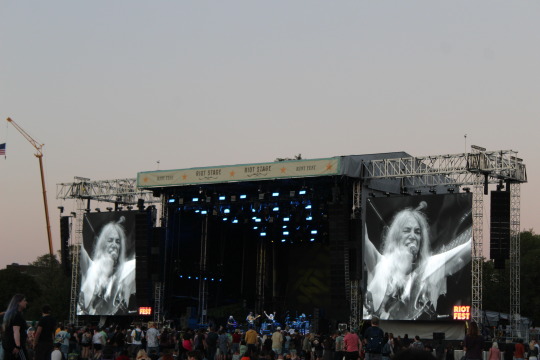
Patti Smith
Behold: a full Patti Smith set! After being shafted by the weather last time around, a sunglasses-laden Smith decided not to fuck around, leading with the inspiring “People Have The Power”, her voice as powerful as I’ve ever heard it. Maybe it was the influence of Riot Fest, but she dropped as many f-bombs as Corey Taylor did during Slipknot’s Sunday night headlining set. After reluctantly signing an adoring crowd member’s copy of Horses, she quipped, “I feel bad for you have to cart that fucking thing around.” It wasn’t just the filthy banter: This was Smith at her most enraptured and incendiary, belting during “Because The Night” and spitting during a “Land/Gloria” medley, reciting stream-of-consciousness hallucinogenic lyrics about the power of escape in the greatest display of stamina the festival had to offer.
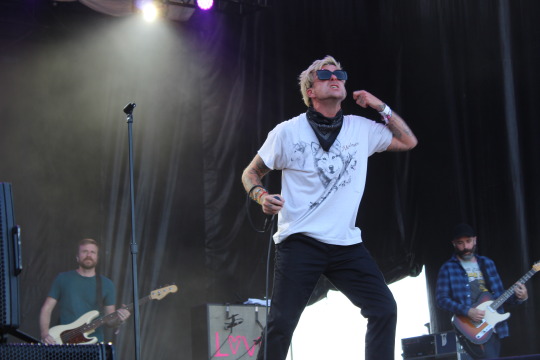
Circa Survive
“It feels good to dance,” declared Circa Survive lead singer Anthony Green. The heart and soul of the Philadelphia rock band, who cover ground from prog rock to post-hardcore and emo, Green was in full form during the band’s early Friday set, his falsetto carrying the rolling “The Difference Between Medicine and Poising Is in the Dose” and the chugging “Rites of Investiture”. While the band, too, can throw down, they’re equally interesting when softer and more melodic, Brendan Ekstrom‘s twinkling guitars lifting “Child of the Desert” and “Suitcase”. Ending with the one-two punch of debut Juturna’s introspective “Act Appalled” and Blue Sky Noise’s skyward “Get Out”, Green announced the band would have a new record coming soon, one you hope will cover the sonic and thematic ground of even just those two tracks.
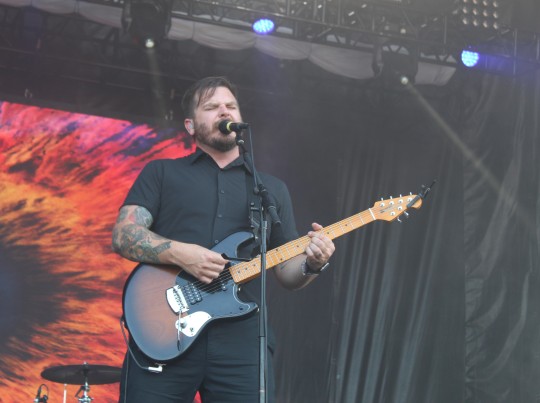
Thrice
Thrice played their first show since February 2020 the same day they’d release their 11th studio album, Horizons/East (Epitaph). To a crowd of fans that came to hear their favorite songs, though, the Irvine, California band knew better than to play a lot of the new record, instead favoring tracks like The Artist in the Ambulance’s spritely title cut and Vheissu standout “The Earth Will Shake”. Yeah, they led with a Horizons/East song making its live debut, the dreamy, almost Deftones-esque “Scavengers”, and later in the set they’d reveal the impassioned “Summer Set Fire to the Rain”. But the set more prominently served to emphasize lead vocalist Dustin Kensrue’s gruff delivery, on “All the World Is Mad” and “in Exile”, the rhythm section’s propulsive playing buoying his fervency. And how about Teppei Teranishi’s finger tapping on “Black Honey”?!? Thrice often favor the slow build-up, but they offered plenty of individually awesome moments.
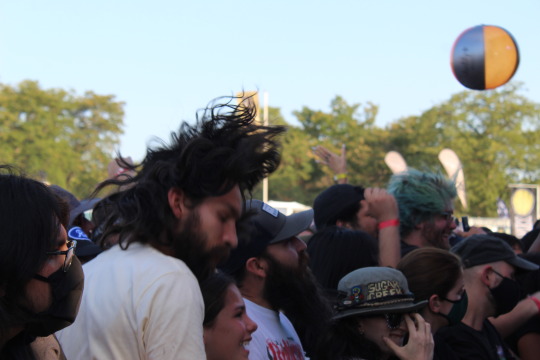
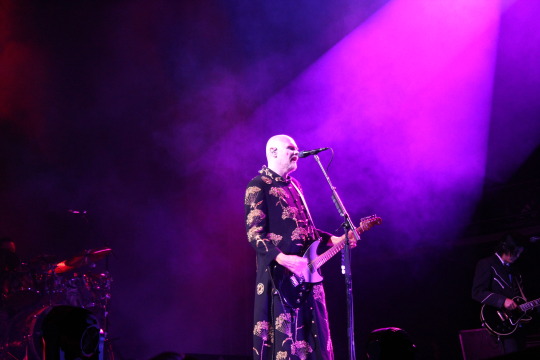
Smashing Pumpkins
William Patrick Corgan entered the stage to dramatic strings, dressed in a robe, with white face paint except for red hearts under his eyes. He looked like a ghost. That’s pretty much where the semi-serious theatricality ended. The Smashing Pumpkins’ first Chicago festival headlining set in recent memory was the rawest they’ve sounded in a while, counting when they played an original lineup-only set at the United Center a few years back. It was also the most fun I’ve ever seen Corgan have on stage. Though they certainly selected and debuted from their latest electropop turn Cyr, Corgan, guitarist James Iha, drummer Jimmy Chamberlin, guitarist Jeff Schroeder, and company more notably dug deep into the vault, playing Gish’s “Crush” for the first time since 2008, Adore’s “Shame” for the first time since 2010, and Siamese Dream barnburner “Quiet” for the first time since 1994 (!). Best, every leftfield disco jam like set opener “The Colour Of Love”, “Cyr”, and “Ramona” was quickly followed by something heavy and/or recognizable, Chamberlin’s limber drum solos elevating even latter-day material like “Solara”. At one point, Corgan, a self-described “arty fuck,” admitted that years ago he would have opted for more experimental material, but he knew the crowd wanted to hear classics, the band then delving into a gorgeous acoustic version of “Tonight, Tonight”. And while Kate Bush coverer Meg Myers came out to sing Lost Highway soundtrack industrial ditty “Eye”, it was none other than legendary local shredder Michael Angelo Batio who stole the show, joining for the set closer, a pummeling version of Zeitgeist highlight “United States”. Leaning into the cheese looks good on you, Billy.
The Bronx
Credit to L.A. punk rock band The Bronx, playing early on a decidedly cooler Saturday early afternoon, for making me put in my earplugs outside of the photo pit. Dedicating “Shitty Future” to Fucked Up (who, as we mentioned, had to drop out), the entire band channeled Damian Abraham’s energy on piercing versions of “Heart Attack American” as well as “Superbloom” and “Curb Feelers” from their latest album Bronx VI (Cooking Vinyl). Joby J. Ford and Ken Horne’s guitars stood out, providing choppy rhythms on “Knifeman” and swirling solos on “Six Days A Week”.
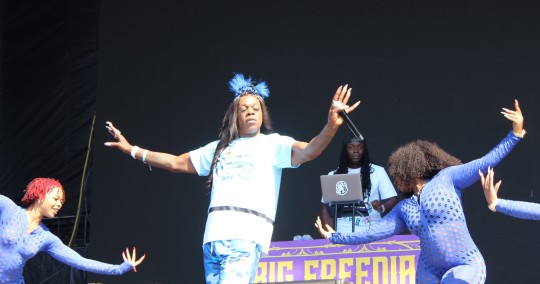
Big Freedia
The New Orleans bounce artist has Big Diva Energy, for the most part. After her DJ pumped up the crowd to contemporary Southern rap staple “Ayy Ladies” by Travis Porter, Big Freedia walked out and showed that “BDE”, firing through singles like “Platinum” and “N.O. Bounce” as her on-stage dancers’ moves ranged from delicate to earth-shaking. At this point, Freedia can pretty much do whatever she wants, effortlessly segueing between a cover of Drake’s “Nice For What” to “Strut”, her single with electropop DJ Elohim, to a cover of Beyone’s “Formation”. Of course, the set highlight was when she had volunteers from the crowd come up and shake and twerk--two at a time to keep it COVID-safe--all while egging them on to go harder. Towards the end of the set, after performing the milquetoast “Goin’ Looney” from the even-worse-than-expected Space Jam: A New Legacy soundtrack, she pulled out the beloved “Gin in my System”. “I got that gin in my system,” she sang, the crowd singing back, “Somebody gonna be my victim,” a refrain that compositionally not only leaves plenty of room for the thundering bass but is thematically a statement of total power--over sexism, racism, the patriarchy--even in the face of control-altering substances.


Les Savy Fav
During Les Savy Fav’s set, lead singer Tim Harrington at various points--*big breath*--went into the crowd, deepthroated an audience member’s mohawk spike, found a discarded manikin head with a wig on it, revealed the words “deep” and “dish” painted on his thighs and a drawing of a Red Hot on his back, rode a crowd member like a horse, made a headband out of pink tape, donned ski goggles, surfed on top of a door carried by the crowd, squeezed his belly while the camera was on it to make it look like his belly button was singing, and referred to himself as a “slippery eel.” Indeed, the legend of Les Savy Fav’s live show starts and ends with Harrington’s ridiculous antics, as he’s all but out of breath when actually singing dance-punk classics like “Hold On To Your Genre”, “The Sweat Descends”, and “Rome (Written Upside Down)”. We haven’t heard much in terms of new music from Les Savy Fav in over 10 years--their most recent album was 2010′s Root For Ruin--but I could see them and the extremely Aughts genre in general become staples of Riot Fest as albums like Inches, The Rapture’s Echoes, and !!!’s Louden Up Now reach the 20-year mark. Dynamic vocalists, tight bands, and killer grooves: What’s not to love?


State Champs
This set likely wins the award for “most immediate crowd surfers,” which I guess is to be expected when you begin your set with a classic track 1--album 1 combination. “Elevated” is the State Champs number that will cause passers-by to stop and watch a couple songs, the type of song that can pretty much only open or close a set. And because they opened with it, the crowd immediately ramped up the energy. It’s been three years since the last State Champs full-length, Living Proof, so they were in prime position to play some new songs. As such, they performed their bubblegummy “Outta My Head” and “Just Sound” and faithfully covered Fall Out Boy’s “Chicago Is So Two Years Ago” (releasing a studio version earlier this week). But the tracks from The Finer Things and Around the World and Back were, as usual, the highlights, like “All You Are Is History”, “Remedy”, “Slow Burn”, and set closer “Secrets”. At the end of the day, it didn’t entirely matter: The crowd knew every word of every song.


Bayside
Putting State Champs and Bayside back-to-back on the same stage made an easy decision for the many pop-punk bands at Riot Fest. Bayside’s been at it for twice as long, so the breadth of their setlist across their discography is more variable. Moreover, they’ve thrice revisited their discography with acoustic albums of old songs, so even their staples are subject to change. They provided solid versions of Killing Time standouts “Already Gone” and “Sick, Sick, Sick”, Cult’s “Pigsty”, and older songs like their self-titled’s “Montauk” and Sirens and Condolences’ “Masterpiece”. For “Don’t Call Me Peanut”, though, they brought out--*gasp*--an acoustic guitar! It was a rare moment not just for one of the most popular pop punk sets but the festival in general, a breather before Vacancy shout-along “Mary”.
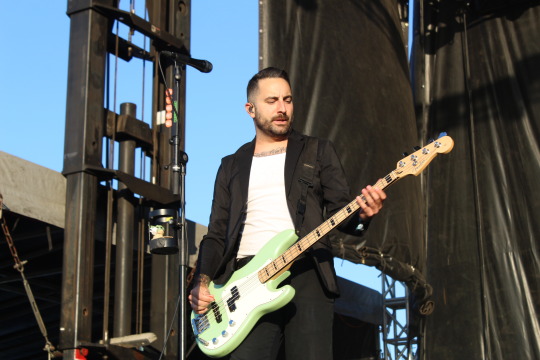
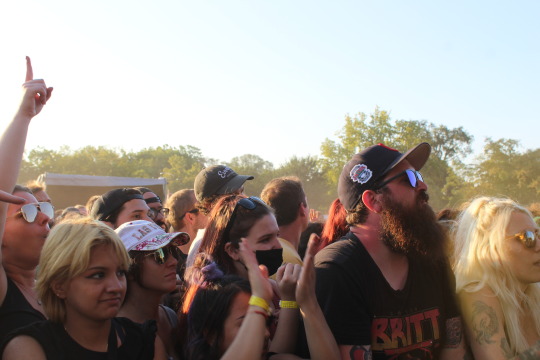
Rancid
“Rancid has always been anti-fascist and anti-racist,” said Tim Armstrong before the band played “Hooligans”. It was nice to hear an explicit declaration of solidarity from the street punks, reminding the crowd what really matters and why we come together to scream and mosh. The band expectedly favored ...And Out Come The Wolves, playing almost half of it, and they perfectly balanced their harder edges with more celebratory ska songs like “Where I’m Going” from their most recent album Trouble Maker (Hellcat/Epitaph). My two favorite moments? The breezy, keyboard-laden “Fall Back Down” from their supremely underrated 2001 album Indestructable, and when they asked the crowd whether they wanted the set to end with “Time Bomb” or “Ruby Soho”. “We have 4 minutes left, and it’s disrespectful to play over your set time,” said Armstrong. It’s easy to see why Rancid continues to make an impression--instrumental and moral--on touring bands new and old.

Run the Jewels
The brilliant hip hop duo are masters of balancing social consciousness with the desire to fuck shit up for fun. Live, the former tends to come in between-song banter, the latter with their actual charismatic, tit-for-tat performances of the songs. However, Run the Jewels also are probably the clearest live performers in hip hop today, Killer Mike and El-P’s words, hypersexual and woke alike, ringing in the ears of audience members who don’t even know the songs. (Looking around, I could see people smiling and laughing at every dick joke, nodding at each righteous proclamation.) Some of the best songs on their most recent album RTJ4 (Jewel Runners/BMG) are perfect for these multitudes. Hearing both RTJ MCs and the backing track of Pharrell Williams and Zack de la Rocha chanting “Look at all these slave masters posin’ on yo’ dollar” on “JU$T” as the rowdy crowd bounced up and down was the ultimate festival moment. For those who had never seen RTJ, it was clear from the get-go, as Killer Mike and EL-P traded bars on “yankee and the brave (ep. 4)” that they’re a unique hip hop act. For the rest of us, it was clear that Run the Jewels keep getting better.
The Gories
It felt a little weird that legendary Detroit trio The Gories were given the first set of the final day--I’d have thought they’d have more draw than that. No matter what, they provided one of the more satisfying and stylistically varied sets of the festival, showcasing their trademark balance of garage punk and blues. Mick Collins and Dan Kroha’s guitar and vocal harmonies were the perfect jangly balance to Peggy O’Neill’s meat and potatoes drumming on “Sister Ann” and “Charm Bag”, while folks less familiar with The Gories were treated to their fantastic covers of Suicide’s “Ghost Rider” and The Keggs’ “To Find Out”. Smells like time for the first Gories album in 20 years!

FACS
I thought it would be ill-fitting to watch a band like FACS in the hot sun, early in the day. Their monochrome brand of post-punk seems better suited for a dimly lit club. But the hypnotic nature of Brian Case’s swirling guitar and Alianna Kalaba’s slinky bass was oddly perfect in a sweltering, faint-inducing heat. Just when you thought you might fade, squalls of feedback and Noah Leger’s odd time signatures picked you back up. Songs from their new album Present Tense (Trouble In Mind) such as “Strawberry Cough” and “XOUT” were emblematic of this push-pull. And everything from the band’s red, white, and black color palate to their lack of stage banter suggested a cool minimalism that was rare at a festival that tends to book more outwardly emotional bands.
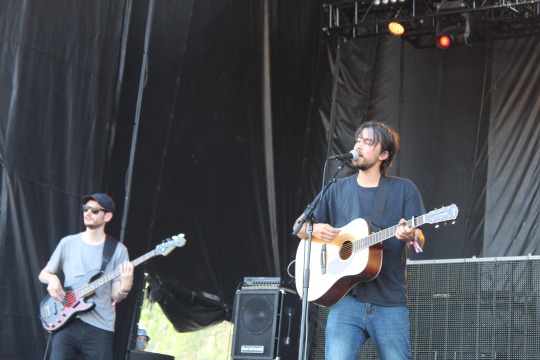
Alex G
On one hand, Alex G’s unique combination of twangy alt country and earnest indie rock makes him an outlier at Riot Fest, or at the very least a mostly Pitchfork/occasional Riot Fest type of booking. On the other hand, like a lot of bands at the festival, he has a rabid fanbase, one that knows his back catalog hits, like “Kute”, “Kicker”, and “Bug”, as much as if not more than hyped Rocket and House of Sugar singles, like “Bobby” and “Gretel”. Backed by a band that knows when to be loose and when to tighten up--and the instrumental chops to do so--Alex G was better than he was a Pitchfork three years ago. He still sings through his teeth, making it especially hard to hear him on louder tunes such as “Brick”. But when the honesty of his vocals combines with the dreamy guitars of “Southern Sky” and circular melodies of “Near”, it’s pure bliss.

HEALTH
The formula for the LA industrial noise band has pretty much always been Jake Duzsik’s soft vocals contrasting John Famiglietti’s screeching bass and pedals and BJ Miller’s mammoth drums. Both in 2018 and Sunday at Riot Fest, the heat affected Famiglietti’s pedals, which were nonetheless obscured by tarp. Or so HEALTH claimed: You wouldn’t know the difference given how much their sound envelops your whole body during one of their live sets. Since their previous appearance at the festival, the prolific band has released two new records on Loma Vista, Vol. 4: Slaves of Fear and collaboration record Disco4: Part 1. Songs from those records occupied half of their excellent set, including battering opener “GOD BOTHERER”, “BODY/PRISON”, and “THE MESSAGE”. It was so wonderfully loud it drowned out K.Flay’s sound check drummer, thank the lord.
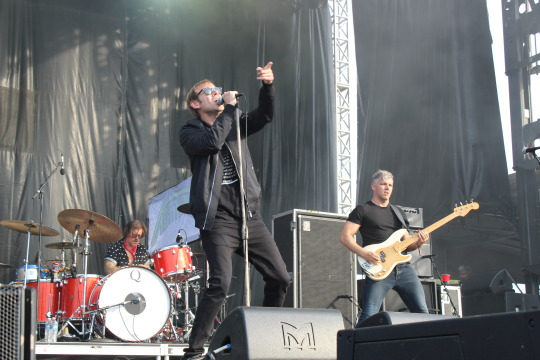
Thursday
Last time Thursday played Riot Fest, Geoff Rickly was battling heroin addiction, something he talked about during the band’s triumphant late afternoon set on Sunday. He mentioned the kindness of the late, great Riley Gale of Power Trip in extending a helping hand when he was down and extended his love to anybody in the crowd or even the world at large going through something similar. To say that this set was life-affirming would be an understatement; after 636 days of no shows, Rickly was at his most passionate. He introduced “Signals Over The Air” as a song the band “wrote about men beating up on women in the pit,” that a record exec at the time told them that it wouldn’t age well because he thought--no kidding--sexism would eventually end. Rickly’s voice, suffering from sound issues last time around, simply soared during Full Collapse’s “Cross Out The Eyes”, No Devolucion’s “Fast to the End”, and two inspired covers: Bruce Springsteen’s “Dancing in the Dark” and Texas Is The Reason’s “If It's Here When We Get Back It's Ours”. The latter the band played because TITR guitarist Norman Brannon’s actually on tour with them, though Rickly emphasized the influence the NYC post-hardcore greats had on Thursday when they first started. Never forgetting where they’ve come from, with self-deprecating humor and radical empathy, Thursday are once again a force.

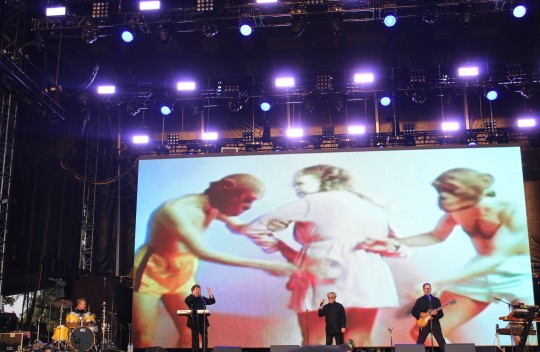
Devo
Much like the B-52′s in 2019, Devo was the set this year of a 70′s/80′s absurd punk band with some radio hits that everybody knows but with a swath of die-hard fans, too. It’s safe to say both groups were satisfied. You walked around the fest all day wondering whether the folks wearing Devo hats were actual fans or doing it for the novelty. By the time the band actually took the stage after a career-spanning video of their many phases, it didn’t really matter, because it was clear the band still had it, Mark and Bob Mothersbaugh and Gerald Casale’s vocals booming throughout a massive crowd. They ripped through “Peek-a-Boo”, “Going Under”, “That’s Good”, “Girl U Want”, and “Whip It”, which caused the fans waiting for Slipknot (and presumably some Devo heads) to form a circle pit. And that was all before the first costume change. Mark passed out hats to the crowd, fully embracing converts who might have only known “Whip It”. The feverish chants of “Uncontrollable Urge” and synth freakouts of “Jocko Homo” whipped everyone into a frenzy. And the band performed the “Freedom Of Choice” theme song for the first time since the early 80′s! I had seen Devo before, opening for Arcade Fire and Dan Deacon at the United Center, but the atmosphere at Riot Fest was more appropriately ludicrous.


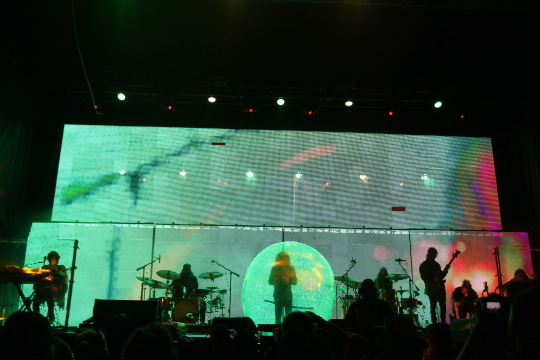
Flaming Lips
“The Flaming Lips are the most COVID-safe band in the world,” went the ongoing joke, as throughout the pandemic they’d give audience members bubbles for their bubbles to be able to play shows. The normally goofy and interactive band scaled back for Riot Fest. Before launching into their traditional opener “Race For The Prize”, Wayne Coyne explained that while the band is normally proud of where they come from--Oklahoma City--they’re saddened by the local government’s ignorant pandemic response and wouldn’t risk launching balloons or walking into the crowd because they might be virus spreaders coming from such an under-vaccinated area. To his and the band’s credit, they wore masks during the performance, even when singing; Coyne removed his only when outside of his bubble that had to be deflated and inflated many times and that sometimes muffled his singing voice even more than a mask. Ever the innovative band, they still put on a stellar show. Coyne autotuned his voice on “Yoshimi Battles the Pink Robots, Pt. 1″, making it another instrument filling the song’s glorious pop melodies. Less heavy on props, the band favored a glitchy, psychedelic setlist that alternated between beauty (”Flowers Of Neptune 6″, “Feeling Yourself Disintegrate”, “All We Have Is Now”) and two-drummed cacophony (“Silver Trembling Hands”, “The W.A.N.D.”). They’ll give a proper Lips show soon enough, but in the meantime, it was nice to see them not run through the motions.
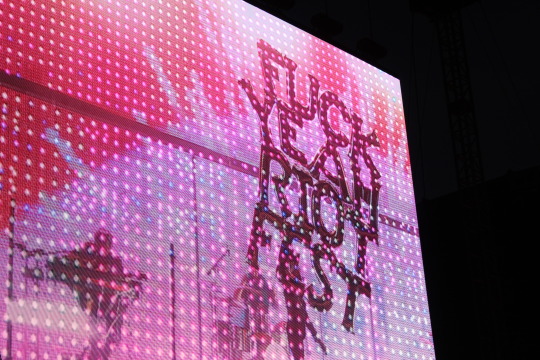
Slipknot
Apart from maybe moments of Slayer, I’ve never witnessed a headliner at Riot Fest as heavy as Slipknot was. Even the minor ethereal elements present on their most recent and very good album We Are Not Your Kind, like the chorus of voices during “Unsainted”, were all but abandoned live in favor of straight up brutality. Sure, there were moments of theatricality--Corey Taylor’s menacing laugh on “Disasterpiece” and pyrotechnics in sequence with the instrumentation on “Before I Forget” and “All Out Life”--but for the most part, Slipknot was the ultimate exorcism. Taylor’s new mask, with unnaturally circular eyes, seemed like it came from a particularly uncomfortable skit from I Think You Should Leave. They bashed a baseball bat to a barrel during the pre-encore performance of “Duality”. And the songs played from tape, like the gasping-for-breath “(515)”, were designed to contrast Slipknot’s alien appearance with qualities that were uncannily human. For a band whose performances and instrumental dexterity are otherworldly--who else can pull off tempo changes over a hissing, Aphex Twin-like shuffling electronic beat on “Eyeless”--the pure seething emotion on songs like “Psychosocial” and “Wait and Bleed” shone through. Like Smashing Pumpkins, and like so many other successful Riot Fest headliners, Slipknot abandoned drama for pure, unadulterated dirt.


#live music#riot fest#wdrl#joyce manor#patti smith#circa survive#thrice#smashing pumpkins#the bronx#big freedia#les savy fav#state champs#bayside#rancid#run the jewels#the gories#facs#alex g#health#thursday#devo#flaming lips#slipknot#barry johnson#chase knobbe#colin frangicetto#eddie breckenridge#riley breckenridge#james iha#matt caughthran
4 notes
·
View notes
Text
LORNA SIMPSON

Lorna Simpson, The Water Bearer (1986)
https://www.nytimes.com/2007/03/02/arts/design/02lorn.html
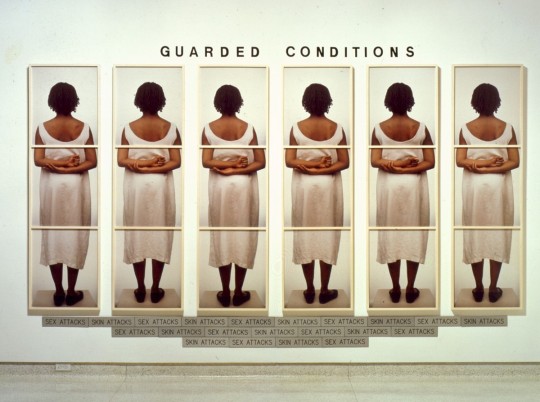
Lorna Simpson, Guarded Conditions (1989)
https://www.artspace.com/magazine/art_101/book_report/representing-the-black-body-lorna-simpson-in-conversation-with-thelma-golden-54624
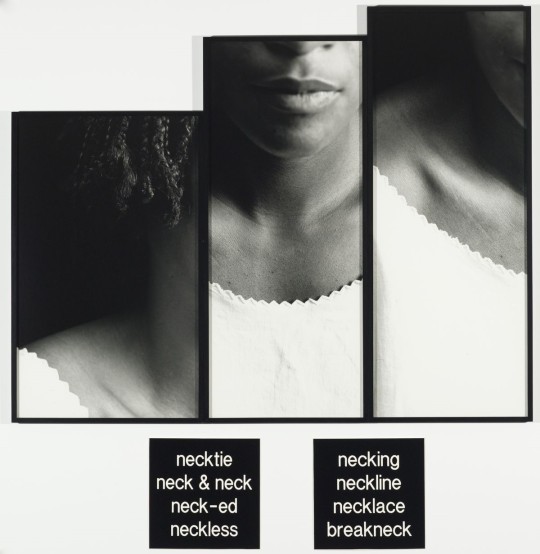
Lorna Simpson, Necklines (1989)
https://mcachicago.org/Collection/Items/1989/Lorna-Simpson-Necklines-1989

Lorna Simpson Wigs (1994)
https://www.moma.org/learn/moma_learning/lorna-simpson-wigs-1994/
Childhood
Born in Brooklyn in 1960, Lorna Simpson was an only child to a Jamaican-Cuban father and an African American mother. Her parents were left-leaning intellectuals who immersed their daughter in group gatherings and cultural events from a young age. She attributed their influence as the sole reason she became an artist, writing, "From a young age, I was immersed in the arts. I had parents who loved living in New York and loved going to museums, and attending plays, dance performances, concerts... my artistic interests have everything to do with the fact that they took me everywhere ...."
Aspects of day-to-day life lit up Simpson's young imagination, from the jazz music of John Coltrane and Miles Davis, to magazine advertisements and overheard, hushed stories shared between adults; all of which would come to shape her future art. The artist took dance classes as a child and when she was around 11 years old, she took part in a theatrical performance at the Lincoln Center for which she donned a gold bodysuit and matching shoes. Though she remembered being incredibly self-conscious, it was a valuable learning experience, one that helped her realize she was better suited as an observer than a performer. This early coming-of-age experience was later documented in the artwork Momentum, (2010).
Simpson's creative training began as a teenager with a series of short art courses at the Art Institute of Chicago, where her grandmother lived. This was followed by attendance at New York's High School of Art and Design, which, she recalls "...introduced me to photography and graphic design."
Early Training and Work
After graduating from high school Simpson earned a place at New York's School of Visual Arts. She had initially hoped to train as a painter, but it soon became clear that her skills lay elsewhere, as she explained in an interview, "everybody (else) was so much better (at painting). I felt like, Oh God, I'm just slaving away at this." By contrast, she discovered a raw immediacy in photography, which "opened up a dialogue with the world."
When she was still a student Simpson took an internship with the Studio Museum in Harlem, which further expanded her way of thinking about the role of art in society. It was here that she first saw the work of Charles Abramson and Adrian Piper, as well as meeting the leading Conceptual artist David Hammons. Each of these artists explored their mixed racial heritage through art, encouraging Simpson to follow a similar path. Yet she is quick to point out how these artists were in a minority at the time, remembering, "When I was a student, the work of artists from varying cultural contexts was not as broad as it is now."
During her student years Simpson travelled throughout Europe and North Africa with her camera, making a series of photographs of street life inspired by the candid languages of Henri Cartier-Bresson and Roy DeCarava. But by graduation, Simpson felt she had already exhausted the documentary style. Taking a break from photography, she moved toward graphic design, producing for a travel company. Yet she remained connected to the underground art scene, mingling with likeminded spirits and fellow African Americans who felt the same rising frustrations as racism, poverty, and unemployment ran deep into the core of their communities.
At an event in New York Simpson met Carrie-Mae Weems, who was a fellow African American student at the University of California. Weems persuaded Simpson to make the move to California with her. "It was a rainy, icy New York evening," remembers Simpson, "and that sounded really good to me." After enrolling at the University of California's MFA program, Simpson found she was increasingly drawn towards a conceptual language, explaining how, "When I was in grad school, at University of California, San Diego, I focused more on performance and conceptually based art." Her earliest existing photographs of the time were made from models staged in a studio under which she put panels or excerpts of text lifted from newspapers or magazines, echoing the graphic approaches of Jenny Holzer and Martha Rosler. The words usually related to the inequalities surrounding the lives of Black Americans, particularly women. Including text immediately added a greater level of complexity to the images, while tying them to painfully difficult current events with a deftly subtle hand.
Mature Period
Simpson's tutors in California weren't convinced by her radical new slant on photography, but after moving back to New York in 1985, she found both a willing audience and a kinship with other artists who were gaining the confidence to speak out about wider cultural diversities and issues of marginalization. Simpson says, "If you are not Native American and your people haven't been here for centuries before the settlement of America, then those experiences have to be regarded as valuable, and we have to acknowledge each other."
Simpson had hit her stride by the late 1980s. Her distinctive, uncompromising ability to address racial inequalities through combinations of image and text had gained momentum and earned her a national following across the United States. She began using both her own photography and found, segregation-era images alongside passages of text that gave fair representation to her subjects. One of her most celebrated works was The Water Bearer, (1986), combining documentation of a young woman pouring water with the inscription: "She saw him disappear by the river. They asked her to tell what happened, only to discount her memory." Simpson deliberately challenged preconceived ideas about first appearances with the inclusion of texts like this one. The concept of personal memory is also one which has become a recurring theme in Simpson's practice, particularly in relation to so many who have struggled to be heard and understood. She observes, "... what one wants to voice in terms of memory doesn't always get acknowledged."
In the 1990s Simpson was one of the first African American women to be included in the Venice Biennale. It was a career-defining decade for Simpson as her status grew to new heights, including a solo exhibition at New York's Museum of Modern Art in 1990 and a series of international residencies and displays. She met and married the artist James Casebere not long after, and their daughter Zora was born in the same decade. In 1994 Simpson began working with her grandmother's old copies of 1950s magazines including Ebony and Jet, aimed at the African American community. Cutting apart these relics from another era allowed Simpson to revise and reinvent the prescribed ideals being pushed onto Black women of the time, as seen in the lithograph series Wigs (1994). The use of tableaus and repetition also became a defining feature of her work, alongside cropped body parts to emphasize the historical objectification of Black bodies.
Current Work
In more recent years Simpson has embraced a much wider pool of materials including film and performance. Her large-scale video installations such as Cloudscape (2004) and Momentum (2011) have taken on an ethereal quality, addressing themes around memory and representation with oblique yet haunting references to the past through music, staging, and lighting.
Between 2011 and 2017 Simpson reworked her Ebony and Jet collages of the 1990s by adding swirls of candy-hued, watercolour hair as a further form of liberation. She has also re-embraced painting through wild, inhospitable landscapes sometimes combined with figurative elements. The images hearken to the continual chilling racial divisions in American culture. As she explains, "American politics have, in my opinion, reverted back to a caste that none of us want to return to..."
Today, Simpson remains in her hometown of Brooklyn, New York, where in March 2020, she began a series of collages following the rise of the Covid-19 crisis. The works express a more intimate response to wider political concerns. She explains, "I'm just using my collages as a way of letting my subconscious do its thing - basically giving my imagination a quiet and peaceful space in which to flourish. Some of the pieces are really an expression of longing, like Walk with Me, (2020) which reflects that incredibly powerful desire to be with friends right now."
Despite her status as a towering figure of American art, Simpson still feels surprised by the level of her own success, particularly when she compares her work to those of her contemporaries. "I feel there are so many people - other artists who were around when I was in my twenties - who I really loved and appreciated, and who deserve the same attention and opportunity, like Howardena Pindell or Adrian Piper."
The Legacy of Lorna Simpson
Simpson's interrogation of race and gender issues with a minimal, sophisticated interplay between art and language has made her a much respected and influential figure within the realms of visual culture. American artist Glenn Ligon is a contemporary of Simpson's whose work similarly utilizes a visual relationship with text, which he calls 'intertextuality,' exploring how stencilled letters spelling out literary fragments, jokes or quotations relating to African-American culture can lead us to re-evaluate pre-conceived ideas from the past. Ligon was one of the founders of the term "Post-Blackness," formed with curator and writer Thelma Golden in the late 1990s, referring to a post-civil rights generation of African-American artists who wanted their art to not just be defined in terms of race alone. In the term Post-Black, they hoped to find "the liberating value in tossing off the immense burden of race-wide representation, the idea that everything they do must speak to or for or about the entire race."
The re-contextualization of historical inaccuracies in both Simpson and Ligon's practice is further echoed in the fearless, cut-out silhouettes of American artist Kara Walker, who walks headlong into some of the most challenging territory from American history. Arranging figures into theatrical narrative displays, she retells horrific stories from the colonial era with grossly exaggerated caricatures that force viewers into deeply uncomfortable territory.
In contrast, contemporary American artist Ellen Gallagher has tapped into the appropriation and repetition of Simpson's visual art, particularly her collages taken from African American magazine culture. Gallagher similarly lifts original source matter from vintage magazines including Ebony, Our World and Sepia, cutting apart and transforming found imagery with a range of unusual materials including plasticine and gold-leaf. Covering or masking areas of her figures' faces and hairstyles highlights the complexities of race in today's culture, which Gallagher deliberately teases out with materials relating to "mutability and shifting," emphasising the rich diversity of today's multicultural societies around the world.
3 notes
·
View notes
Photo

youtube
Four years ago, Speedy Ortiz leader Sadie Dupuis released a full-length debut, Slugger, under her solo moniker Sad13. Then, back in June, she announced a sophomore outing called Haunted Painting. The latest preview of Haunted Painting is called 'Oops…!' Here’s what Dupuis had to say about it: "We recorded 'Oops…!' at New Monkey, which was Elliott Smith’s studio. This one has a magic drum sound — thanks entirely to engineer Sarah Tudzin (of Illuminati Hotties notoriety), and Zoë Brecher’s impeccable playing. Just before writing it, on tour with CHVRCHES, a venue employee became physically and verbally violent with one of my Speedy Ortiz bandmates. He directed his fake apology at me instead of the person he harmed, presumably because I am smaller and present feminine. My vengeance complex kicked in and I got a scary adrenaline high making sure this unsafe person was removed from the show. While I’m glad I have protective instincts, I wrote the song to process ways in which I’ve used people’s assumptions about me and my body to wield my own version of toxic masculinity. Kimber-Lee Alston, who directed remotely via Zoom, turned this story and song into an allegory about a 1950s prom queen vampire who lures in her bad boy victims with delicious, blood-filled treats." Musically, 'Oops…!' sits between the poppiest ends of Dupuis’ Sad13 songwriting and the more rock-oriented side of her work with Speedy Ortiz. [via Stereogum]
youtube
Lola Young has unveiled a powerful new video for latest track ‘Woman’. As Lola explains when opening up the video - “what you’re about to see is woman in all their glory, in all their pain, unapologetic in their self-love and unashamed in this moment of vanity”. Taking striking visuals and combining it with Lola’s standout voice - the results are a must-watch. Speaking about the video, Lola explains: “I wanted to make this video because I believe women are all undeniably strong, sexy, free, brave, vulnerable, raw and powerful and that we do not have to hide away. We do not have to remain unseen, our bodies should never be sexualised or a taboo conversation, or only seen through the male gaze. We have the ability to normalise our bodies being on show, and accept them for their differences, as It’s important to remember those differences are currently often shamed. I pushed for the women in the video being fully nude and the energy on set because of that was insane. I have never felt more empowered in my life. Nipples, bums, rolls, stretch marks, cellulite, all of these things are beautiful along with the ‘perfect’ body. This is my personal experience of being a woman, hopefully other women will have their own take on what it means to them”. [via Dork]
youtube
'Rivers' is the new single by the musical project of Alexandra Duparc — SKANDRA. This song is a story we have each possibly lived inside. But it’s not one you easily wish to remember. It is a toxic setting wherein who you love is eating away at you and you’re not able to break away. The very muse you draw so much from is the same one that hurts you even while you sleep. 'Rivers' takes you on a journey through the looking-glass both in sentiment and aurally. With synthetic pops, energetic picks, and rhythmic beats, the song will peacefully make your ears and mind, alike, buzz with nostalgia, and fills them with hope for a better future.
youtube
Taking a leap from the Broadway stage to the recording studio is singer-songwriter Sophia Anne Caruso with her debut tune 'Toys'. Teaming up with Empire The Sun’s Nick Littlemore, Sophia’s sweet angelic vocals guide us through this sombre piano melody as she confesses her innermost thoughts and feelings. With raw emotion and a captivating presence, Sophia wanders through ruins of a castle and forest for a stirring cinematic video. The poetic song follows up from the actor’s performance in the Tony-nominated Broadway production of the cult classic Beetlejuice, where she stared as the gothic teenage physic medium Lydia. While she may have conquered the stage with her incandescent performances, the singer is ready to take on the next challenge and we’re excited to see where the next chapter will take her. [via Wonderland]
youtube
Tāmaki Makaurau’s Valkyrie are back with a brand new track ‘Good Thing’, their most infectious bop of a track yet (really – try not to dance to this, we dare you), accompanied by a vivacious and decadently alluring video directed by Shae Sterling. The track is written about the sexiness of Jimi Hendrix and Mick Jagger, and is overflowing with good vibes and energy. Speaking of the idea behind ‘Good Thing’, Valkyrie’s front woman Omer Gilroy says, "Imagine being stuck in isolated nature for a week, surrounded by the Beatles, the Stones and Jimi Hendrix... No cell service, just vinyls of the classics and friends. We had a good thing going and what you hear in the song is how we felt while writing it."
youtube
Two weeks after Kylie Minogue released her new song 'Say Something,' the singer has paired the single with a sparkling video directed by Sophie Muller. Keeping with the Disco theme of her new album and song’s lyrics, the visual finds Minogue and her dancers grooving to 'Say Something' in front of an interstellar backdrop, with the pop singer sometimes delivering the track from atop a horse statue. “We’re a million miles apart/In a thousand ways,” Minogue sings on the upbeat, introspective track. “Baby you can light up the dark/Like a solar-scape.” [via Rolling Stone]
youtube
Los Angeles' DeathbyRomy makes dark, gothic pop with a theatrical edge; the 20-year-old's debut album, 2018's Monsters, is filled with brooding electronic beats as she waxes poetic about her many failed loves, complete with features from Lil B, Yung Bans, and Cuban Doll. DeathbyRomy's most recent single, 'Fiending For A Lover,' though, shows the young artist making a pivot into brighter, more straightforward pop with its upbeat, maximalist production and an intro that feels like a nod to the TikTok famous 'Lalala.' NYLON premiered the song's video, a quarantine-filmed visual that includes a Mean Girls-esque burn book, and the singer dressed to the nines in Harajuku fashion. Lounging in the maximalist pink interiors of her room, the young artist fantasizes about wanting to be tied down again, even if it ends up kind of toxic: "Something in the way you hurt me/ I love it though it's quite unnerving." "This song was inspired by feeling locked up during this quarantine," Romy writes of the song in an email. "An overall sense of lingering mania and being the hopeless romantic I am; I’ve been fantasizing more than ever about my imaginary boyfriend. There may also have been a crush or two who inspired the song….(sneaky smile)." [via NYLON]
youtube
Rising South London singer Greentea Peng has unveiled the brand new visuals for her latest track ‘Hu Man’. Shot by Felix Brady, Greentea Peng says of the new song, “YOU man, me man, WE MAN. Hu Man is an exploration of self and our attachment to identity, especially in this modern age. Hu Man is a war cry from the battlefield of mind, calling to the divine Mother to take this ego, take this head, to remove all these words and man made constructs and take me, take us, back to centre. Back to oneness, forward to unity. In Lak’ech Ala K’in, I am you you are me, is a Mayan saying I encountered during a Ceremony in Mexico and it’s stayed with me always. I find it very fitting for the times we find ourselves in, such shifting paradigms. Hu Man is an offering of peace and healing to the collective in these intense times, and I pray it takes people inside themselves if for only just a moment.” [via DIY]
#videos of the week#sad13#lola young#skandra#sophie anne caruso#valkyrie#kylie minogue#deathbyromy#greentea peng
3 notes
·
View notes
Text
The modern gay male: Consumer profile research- “A”
The social butterfly
Issue: Lacking representation
A was the first gay man I interviewed for this series and I learned a lot about what it means to be a queer, social extrovert in the traditionally introverted, clean-cut environment that is finance. Outgoing and social, A has always known inside his intentions are to work in a face-to-face, people centric environment. In some respect, his degree of finance has opportunity in that way; working with clients on investment portfolios, building meaningful relationships and establishing a solid reputation coinciding with that theme. However, as revealed throughout the interview, representation has squandered that idea in the eyes of a young, gay finance major.
Somehow organically, A began with “I realized with what I wanted to get out of my life, maybe finance wasn’t for me.”
Right off the bat, we may be asking ‘Why is that? ‘ A revealed that he believes several reasons are attributable to his difficulties finding his place in the professional world of finance as a young gay man. “I always knew I wanted to go into finance, I have a math brain,” but acknowledging, “I didn’t really think of the lifestyle.” I wanted to understand the lifestyle portion, and he expanded upon the topic, stating as another point “I never realized as a gay man where we stand. I put myself lower than others. In classes I’m surrounded by straight white people, no one’s doing it to me, but it’s like I’m personally beating myself up, comparing myself to others. Kind of like women in the workplace.”
Clearly, there is a reason why someone would either consciously or subconsciously be inclined to be self- critical to the extent of doubting their path into the future. I asked A his thoughts on how representation directly impacted his experience both academically and personally, and he brought up the reality of suppression. “Employers are gonna go for, naturally, the straight people. I feel like I’m naturally put at a disadvantage because of my sexuality.”
This was interesting, because I was wondering what experience he had which created this perception. “Why do you think you have this preconceived notion that this is going to happen to you?” I asked. “I feel I have to put in extra effort to match everyone else,” being straight professionals, “people look at me like I’m immature, like I’m a crazy, wild gay person. I think professionals would look down on me because of how…gay I am.”
Playing devil’s advocate, I argued, “There’s a difference between personality and sexuality. I think you’re confusing the two in terms of introspection.” A replied, “I know what you’re saying but I feel like when it comes to my personality a lot of this comes from me being gay, being flamboyant. It has its ties to promiscuity and theatrics, and I beat myself up. In a professional workplace sense, I just think the whole flamboyant gay thing is not a thing. Have you ever seen someone like me be a financial advisor?”
I brought up the topic of being in the closet, “There might be people like that but they’re very repressed.” I further praised A for living his truth and reiterated there are and will be people hiding because they are intimidated by an unwelcoming, underrepresented sector.
While on the topic of representation, I wanted to get his opinion on pop culture, media and the stereotypical identity of our community. “I think its entertainment,” I said. A then agreed, saying “People like to paint us out as dramatic and stereotypes are very strong. Our stereotypes are so very strong in media, you know, gay-best-friend” he replied.
We then agreed on noticing some inclusive commercials starting to rise, but he believes “The gays on social media are vultures, easily offended and trying to not walk on eggshells. People are bending with that to fit in.”
“I hear what you’re saying about commercials,” I said, “what kind of ads or brands would you want more representation in for our community?” This is when things got real.
“More in the finance sector. Business. Inspiration. I’m struggling because I don’t see myself in the finance industry and it’s not because I’m not good at finance but me as a person I don’t fit in…Even my finance internship.”
We paused. “Everyone treated me amazing…People were so nice, I loved it. This could be just a ‘me’ thing, but I could sense everyone was stepping on eggshells around me, making sure I was well-fit-in and it made me feel weird. Didn’t want to make me feel different. Us gay people, we can see right through that. Previous interns? Straight white jocks.”
“This says a lot,” I replied, asking “Do you think it has to do with the gay community being underrepresented in the finance world?” He agreed, “I definitely don’t think that’s out-of-pocket; I can’t wrap my head around me being in the finance industry. How do I act? Do I repress myself more?”
I asked him, “Do you think the way you repress yourself now would continue into the future?” “I would change things up,” A said, “I wouldn’t repress myself as much.” “What about starting your own firm and defining what gay finance is?” I asked, “The less a community is represented, the less awareness.” “Well,” A said, “In part…Lack of representation doesn’t make me see myself in finance at all.”
#gay#gaycollege#article#research#marketresearch#consumerism#advertising#marketing#interviewing#queer#gaymen#society#blog#writing#business#acceptance#finance#selfdiscovery#lgbtq#homosexuality#culture#trend#me#you#them#they#their#us#cool#interesting
1 note
·
View note
Text
The Number 25 [2]: Bucky x Reader

Summary: Assigned to protect you for 25 days, Bucky lets his brooding side show. He lets you know that he absolutely does not want to be here, he doesn’t like you, and most importantly, he wants nothing to do with the holiday cheer surrounding this month.
Warnings/Themes: violence/mild gore, Mentions of death, angst, fluff, Bucky gets a kitty, humor, profanity, Bodyguard(ish)!Bucky, lots of christmas/new years/holiday references.
Author’s Note: The amount of fucks I give have dropped to 0. Errors/spelling mistakes have not been looked for.
Last Chapter
Buy me a Ko-fi?
Chapter 2: Your what?
-
Quickly and efficiently, you chop the carrot on the board, humming a soft tune while the TV plays in the background.
An annoying series of knocks ring out from the door. Only one person can make such a racket, and you choose to ignore it.
Another round of knocks and the sounds grow louder, disturbing the peace in your apartment. You groan, trying to hold in the rising irritation.
And when you let a few more minutes go by, the knocking stops. You release a slow breath.
And then the door bursts open, pieces of wood, plaster, and paint fly by and dust the ground. The bang causes you to yelp in surprise, the knife you were holding falling and barely missing your socked foot by a few inches. With a trembling form, you back away from it, whipping your head up to look at your intruder.
He’s not much happier than you, blue eyes blazing with rage and annoyance. “I know you heard me,” he barks, pointing a metal finger in your direction. “Rule number one: anytime I knock? You answer. You can check the fuckin’ peephole for all I care but don’t ever leave me hanging like that.” He chucks a paper bag he’d been holding onto the floor before stomping up to you.
“Are you insane?” you squawk, gesturing toward the entrance door which barely hangs by the top hinge. “You nearly gave me a heart attack, asshole!” He doesn’t notice the tears pricking your eyes. He’s too busy regarding the mess that he made. You try to calm your breathing, try to push aside the anxiety bubbling up from within you. The loud noises only reminded you of the incident. PTSD was a bitch.
When Bucky looks up, you quickly turn your back to him, shielding your frightful expression.
“I’ll get somebody to fix that…” he sighs, clearly underestimating his own strength. “Sorry.”
“Why are you even here?” you mutter. “I don’t have work until 10 today.”
Bucky spots a broom and dustpan beside your kitchen island and takes initiative. As he sweeps, he answers you in a tired tone. He didn’t get much sleep last night, as per usual. “And I have to stop by the tower before then for some reports. I don’t want you walking alone.”
“I’ll be just fine for one day, big guy, the place isn’t that far.”
The scuffing of bristles pauses for a brief moment before continuing much louder. Through his agitation, you understand why some of the strands begin to break as he sweeps.
Bucky scoffs. “I was hired to keep watch. I’m not failing on my third day.”
You roll your eyes, picking the knife back up and dropping it into the sink. It’s been three days since he became your bodyguard. Three days of bickering, long walks to and from work (driving was too risky, apparently), and constant worry. Bucky certainly didn’t make things any easier. He was a raging nut-case, and you were sure he’d bite your head off if given the opportunity.
“Then I guess I’ll have company on the way to work then,” you grumble. You plop the carrots into the broth and use the ladle to stir. That is until a hand covers yours to stop it. Surprisingly, his calloused palm is warm against the back of your hand. You can only watch in confusion and awe as he lifts the ladle, your hand still in his, and blows on the broth to cool it down. He takes a sip and for a split second, you can see a rare smile on his lips.
“Breakfast?”
His gruff voice shakes you out of your stupor. “Lunch,” you respond, yanking your hand grumpily away from his and shaking the ladle over the sink as if it had a disease. “For the week I guess. I don’t go out to eat often. Can’t afford to.”
Bucky hums in agreement, turning to empty out the dustpan into the trashcan. “Seems about right.” What a low blow. “Save some for me?”
“Well, I would’ve been willing to if not for you breaking down my door and subtly throwing shade at me.” You glare daggers into his broad back before covering the pot. “So, no. None for you.”
He doesn’t give you the reaction you expect. Instead of his usual grimace, he smirks cockily, leaning against the counter and shaking his head at you. “What’a shame. I brought doughnuts to share and you can’t even give a poor boy some soup. Any coffee at least?”
“First of all.” You point accusingly in his direction. “I know you get a shit-ton of money as an Avenger, enough to afford some soup, fix my door, and pay five year’s worth of rent if you wanted to.” When he shrugs, you furrow your brows. “Second of all, the coffee’s three cabinets to your left, make yourself useful and get it yourself.”
As you finish up the soup, Bucky pours two cups of coffee, mixing in cream and sugar for the both of you.
-
You’ve been to the tower multiple times now, but you can never get used to how spacious and advanced it looked. You follow a few steps behind Bucky, watching the busy workers scramble around in awe.
It’s the first time since you’ve met that you and Bucky have a moment of silence as you walk. He guides you through hundreds of halls, turning every which way and at some point, you have to wonder if he was leading you around in circles. You don’t have much time to dwell on that thought because he eventually stops at a large intersection. A circulation desk stands before you, and a busty woman with an obnoxious smile flutters her eyelashes at Bucky. He, however, seems less than disinterested.
“Reports, Darlah?” he asks, metal hand outstretched towards her. Almost theatrically, she leans over the desk and plops a file-folder onto it, giggling when he pulls back rather quickly. He mutters a quick ‘thanks’ before opening it up to read.
You can’t help but snort at the exchange. Bucky may have hated you, but he certainly didn’t like this lady any better. Still, he tried his best to stay professional around her. “HI, I’m [Y/N],” you introduce.
A little annoyed, and a little more coldly, she eyes you up and down. “Your girlfriend, James?”
He glances between you and her before rolling his eyes. “That depends on how much you’d hate that.”
“Oh, I’d hate that very much,” she sneers unsettlingly.
Despite his back to you, you can almost see the smirk on his lips. “Then yeah, she’s very much my girlfriend.”
Your eyes widen. “Excuse me --”
“And we’re in love,” Bucky interrupts. “Sooooo madly in love, Darlah.” He turns toward you, a dreamy smile covering up his hidden anguish. “Ain’t that right, Darlin’?”
Oh fuck it. He’s gonna owe you one after this, and you weren’t going to let him forget it.
“Absolutely. Madly. In. Love.” You growl through gritted teeth. When Bucky leans in for a cheek kiss, you subtly tilt your head away, hiding your threat behind doe eyes. “Don’t push it,” you whisper. His tiny smirk kills you inside.
-
A sharp chorus of barks causes Bucky to stiffen as he follows you into the building. You were a kennel worker, and he still wasn’t used to the idea. How could you be so calm when all of these animals were constantly screaming for attention.
It was nice inside, at least. You kept things immaculate and organized. Different from the last time, each kennel had a stocking hanging in front of it with the dogs’ names. He’s learned to remember each one and their unique traits.
Jimmy was a shaking chihuahua, tan and a bit chubby. He acted three-times his size, challenging anyone that towered over him. Yet, whenever you approached and allowed him to sniff you, he’ll take you for his new best friend.
Geraldine was a large, bulky Rottie. Despite the stereotypes, though, she was the biggest sweetheart anyone could ever meet. She was tranquil and barely spoke. Her little nub of a tail wiggled whenever you made eye contact with her.
Minnie and Bandit were a pair of bonded poodles who loved to give kisses and would hop right into your lap without hesitation. Bucky was a victim of their slobbery attacks. They seemed to love him most. While you were working, he’d spend a few hours in their kennel especially.
But Rex? Rex was his absolute favorite. The massive Chow-chow was always ready to zoom around in the backyard, pulling whoever was on the other end of the leash in tow. Still, even when he was strong with the volunteers (and Bucky), he always treated his stuffed animals with care. He would never hurt them, and if you tried to take them away from him, he’d whimper and cry like a little baby. Bucky downright loved him.
There were a few more dogs that resided here in this kennel, and Bucky knew them all. They seemed to come and go every other day, and he doesn’t dare forget. It’s something you can appreciate about the brooding soldier.
“No,” you call out over your shoulder without having to look back. You internally curse at Bucky, seeing him toss a bit of his donut into Rex’s cage. “If he has diarrhea, you’re cleaning it up, asshole.” Bucky simply laughs and tosses you a thumbs-up.
You go on about your daily routine, feeding one dog after the other and overseeing operations as volunteers come to walk them. Meanwhile, Bucky’s in Minnie’s and Bandit’s kennel, scribbling messy doodles of them in his notepad (his professional one for notes, no less). As you wash a few bowls, you can’t help but notice how loud his laughter is, ringing out throughout the building. It was something you never knew you needed until now.
Breaking through that deep laugh is your phone’s ringtone. It clatters against the metal table, earning loud barks from the dogs. You roll your eyes and pick it up.
He never knew when to wait.
As you talk on the phone, you fail to notice that Bucky’s listening intently.
“Yes?” you mutter.
Steve?
“You can’t just call me whenever you want, Ash. I’m sorry but -”
Not Steve.
Bucky slips out from the kennel and leans against it, curiously watching as you pace back and forth in stress.
“No, no. I’m sorry. I’ll be home tonight….You what? -” You frantically wring your hands, glancing up at the clock. Begrudgingly, you sigh. “Okay. I better clean up then.”
When you hang up, Bucky can see the anxiety only grow. Your eyebrows furrow tightly and without having to look closely, Bucky can tell that you’re on the verge of tears.
“Who was that?” He can’t help but ask. You were usually pretty good at hiding things, so whoever was bothering you this much must be a huge asshole.
“My boyfriend,” you answer tersely.
When you turn your back to him, you don’t see the red creeping up Bucky’s face.
#bucky barnes#james bucky barnes#bucky x reader#reader insert#reader imagine#wolf writes#the number 25#series#writing#fanfic#fanfiction#the avengers#the winter soldier#white wolf#captain america#marvel#mcu#angst#fluff
78 notes
·
View notes
Text
Handling the Contents of Consciousness
A case study by Goire Zatla, as provided by Soramimi Hanarejima
Art by Ariel Alian Wilson
Keeping this secret from you has become so taxing that I have to use the venom of sleep bugs to tame the eagerness to divulge it.
In the mornings, I apply this toxin to the region of my memory where the secret resides. A little dab of it spreads easily from my fingertip across that part of my mind, cool and thick, greasy until it dries to leave only a minty, vaporous sensation. It’s marvelously effective. This insect secretion from the local apothecary preemptively soothes the itch, which will otherwise inevitably flare up by the middle of breakfast, and the relief it provides lasts well into the evening. After a few days of performing this practice, it is assimilated into my morning bathroom routine, tucked cozily between washing my face and brushing my teeth. Like I’ve been doing this for years.
But after a week, I find that this use of sleep bug venom does have at least one side effect. It is numbing me to beauty. When I see a meteor shower or moonbow or quadrilateral triangle or northern pygmy owl, I merely note it as an exceptional phenomenon. No longer am I enthralled by that sense of ethereal, transient joy.
While this is concerning, the numbness to beauty does present one benefit: I will be able to converse with Qalixy without being in awe of her gorgeous personality.
So I arrange to meet her in conference room R, to provide critical, candid project feedback with a state of mind undistracted by her psychological splendor.
And indeed, within minutes of sitting down at the conference table, I’ve delivered all my comments on her work with pithy honesty. This leaves her plenty of time to ask follow-up questions, most of which are concerned with my emotional responses to key facets of her project, particularly metaphor repurposing and thought nucleation catalysis.
“But how does that make you feel?” she keeps asking.
Unable to experience the inflections of her voice as aurally aesthetic, I can answer all her questions immediately and succinctly.
We move quickly through her concerns and curiosities, and soon, our discussion is metamorphosing into genial conversation. So much so that we end up talking about emotional dexterity. And were I not in the beauty-impervious state that I’m in, I would no doubt be hung up on how uncommonly pretty her ideas on this subject are. Their arcs and colors and twirls verge on–almost veer into–the eccentric, yet remain firmly masterful in the domain of the articulate and cogent. They convince me to try the training routines she recommends and to take her up on her offer of going to emotional workout sessions with her.
The regimen starts with works of art that are unyieldingly evocative, literature and film that cover varied psychological ground at breakneck speeds, full of dynamic characters in ever-evolving situations that evoke one emotion after another for me to handle in unabating succession.
From there, I move on to paintings and photographs that are dense with emotional content ranging from overt sentiment to nuanced suggestion. The most confounding of these is of a teenage boy happening upon a man watering his melon patch as hulking monsters duke it out in the hills behind him. With a backpack purposefully shouldered, the boy appears to have somewhere he’s headed but is now thrust into a moment of reconsideration by this encounter, which has resulted in a posture of puzzlement, a countenance of consternation. The man’s expression seems to be one of calm worry, of anxieties reconciled enough to be only mildly troubling in this moment. Is it the menacing clash of beasts behind him that stirs the agitation he has quieted? Or is it something else entirely?
Another painting unnerves me with its incongruous elements–an understated goodbye, a butterfly in a jar, looming jealousy and tufts of harvested wheat–all coexisting placidly, as if in a carefully balanced state.
Steadily, I work my way through the assortment of visual works she has curated for me, each one pushing me to grapple with an ever-bulkier load of emotional material. Then I graduate into the echelon of theatrical productions, poetry slams, sketch comedy shows and other narrative forms that present numerous emotions nearly simultaneously. Each forces me to manage my psychological responses, holding some to the side while new ones enter. I am challenged to unfold sympathy while clutching outrage, put longing at arm’s length so appreciation can be brought closer, embrace humor one moment and in the next cast it to the edges of my attention to wrangle heartache and compassion. Typically, I must do all this from the confines of a narrow theater seat, amidst the exuberance of a boisterous audience, without the benefit of even a notepad to shelve a feeling or thought. And there, pushed to the brink of my capacities to experience and handle emotions, I become a blossoming of the human potential to be emotionally limber and active with audacious tenacity.
The emotional vigor of the artistic worlds she’s brought me into astounds me relentlessly.
“Aren’t you a fast learner,” she says two weeks into this.
We’ve just finished a workout–a rambunctious, entrepreneurship-themed musical this time–and I’m catching my breath.
“I’m impressed,” she adds with a smile.
“Yes … well … I do feel like … I’ve got a bit of a … knack for this,” I answer, still winded. “And it probably helps that … I’m not distracted by beauty.”
“What do you mean?” she asks, smile fading.
I briefly explain my use of sleep bug venom.
“Oh no, no, no, no,” she says, shaking her head. “That won’t do at all. Beauty is a deep part of all this. I can’t believe you’ve been missing out on that.”
“Missing out on what?” I ask in earnest; it didn’t seem like I was missing out on anything.
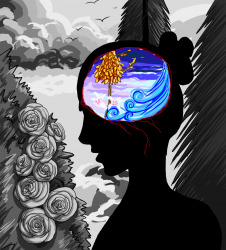
That won’t do at all. Beauty is a deep part of all this. I can’t believe you’ve been missing out on that.
“It’s hard to explain, but basically, beauty is one of those things you have to juggle along with everything else, and also, the whole act of juggling is itself beautiful. That’s a drastic oversimplification. You need to experience it. You cannot truly know emotional dexterity while you’re untouchable by beauty.”
I worry about spilling the secret to you or someone else if I lay off the venom, but she is very clear on this point.
“Okay, I’ll give it a try,” I assure her.
She smiles again. I try to figure out if this one is wider than the last.
The next morning, I embark upon a hiatus from the daily application of insect-derived sedative. Cutting this activity from my morning makes my wake-up bathroom routine feel incomplete–wrongly abbreviated. But as I have breakfast and get ready for the day, I feel delightfully normal and become optimistic that the secret has lost its potency, its power subdued by repeated use of the toxin. But this is of course too good to be true.
While walking my customary path along the riverbank, I feel the desire to reveal the secret coming on. It’s faint but growing steadily. I pick up the pace, hoping that moving faster will divert energy from the rising compulsion.
But the urge only gains urgency. I become concerned that I’ll shout out the secret, yell like I’m trying to tell it to someone across the river. Anxious, I reach for the vial of sleep bug secretion I’ve kept in my bag all these weeks, just in case.
Then the morning sunlight on the river catches my attention. It sparkles like it’s flecks of luminous, filmy material floating out there, following every fluctuation of the water’s surface.
As I pause to admire the interplay of light and liquid, my hand falls away from my bag. The beauty of this sight has displaced the urge to divulge. That fact is itself beautiful.
Feeling at ease now, I conclude that when the secret threatens to burst out, I just need to have something beautiful to direct my attention to. Fortunately, you’ve supplied me with just that. In my bag, there’s a postcard from you, a mesmerizingly colorful scene of a mountainside covered in wildflowers from your recent trip to Nolinga Canyon.
As soon as I arrive at work, I place the postcard in the lower right corner of my desk, for easy glanceability. I feel as though I’m back in kindergarten, with my security blanket kept close at hand. Every few minutes, my head turns for a look at the postcard, like I’m afraid someone will swipe it from my desk. These frequent, small doses of the floral landscape seem to ward off the symptoms of secret bearing and keep me feeling almost normal, which delights me.
When it’s time to assemble for the team meeting, I pluck the postcard from my desk and tuck it in the back of my notebook before heading to the conference room. Briefly I muse that to some onlooker, it could appear that I can’t bear to leave the postcard behind, that it’s some vital memento of you.
As fellow members of Team Snurgler get settled around the conference table, I open my notebook. Then I place the postcard on the left page the notebook is open to. Wernt’s gaze is immediately drawn to it, probably because the postcard is the most colorful thing on the conference table. I become self-conscious about having it out, and when he’s not looking, I discreetly put the postcard among the unused pages toward the end of the notebook. When needed, I can sneak a glance at it back there during the meeting.
But when Qalixy enters the conference room a minute later, I know that won’t be necessary. I can admire her personality from across the room when in need of beauty.
And that’s exactly what I do 17 minutes into the meeting. I fixate on her elegant integrity and splendid insightfulness, the prettiness of her lightly prissy conduct. Her qualities easily hold at bay the pressures exerted by the secret. I settle comfortably into her sheer magnificence for wondrous, pacifying minutes, until her eyes flit up and meet mine. We regard each other for some very long seconds. Then she smiles at me.
Abruptly she rises from her seat and leaves the conference room.
My eyes widen as I begin to fret. The deprivation of her beauty leaves me feeling as if the secret is with tremendous force pushing its way out of its confinement in my memory. I might have to step out of the meeting myself. Or flip to the back pages of my notebook, to look at the postcard at the risk of piquing the curiosity of the team members near me.
In the midst of my mini-anxiety attack, I hear Bonrol say, “It may seem harsh, but we must be anti-mediocrean on this.”
“Exactly right,” Kierce joins in. “We have our potentialist values to uphold.”
These words resonate with me, despite my confusion about what exactly they refer to. I’ve lost track of the discussion while lost in Qalixy’s beautiful qualities, but hearing Bonrol and Kierce take this stand, feeling the unmistakable passion in their voices, roused within me is a keen sense of camaraderie, my long reticent aspirations of living the tenets of potentialism stirring to life.
Amid this, a quiet awe suffuses me.
My admiration for my peers, a consternation over what has evoked their vehemence, the trying nature of this secret, the knowingness in Qalixy’s smile, the reassuring brightness of the sky outside–it’s all strikingly beautiful.
And I can juggle them adeptly as I re-engage myself in the proceedings of the meeting, handling these feelings just like so many others I have during my training.
And that is unmistakably beautiful.
Having forsaken aspirations to join the intelligentsia, Goire Zatla is a metaphysiologist whose research focuses on memory, emotion, and consciousness. Goire’s recent studies have examined the properties possessed by a shard of shattered attention and responses to immoderate chronesthesia.
Soramimi Hanarejima is a writer of innovative fiction and the author of Visits to the Confabulatorium, a fanciful story collection that Jack Cheng said “captures moonlight in Ziploc bags.” Soramimi’s recent work has appeared in various literary magazines, including Panoply, Pulp Literature, and The Absurdist.
Ariel Alian Wilson is a few things: artist, writer, gamer, and role-player. Having dabbled in a few different art mediums, Ariel has been drawing since she was small, having always held a passion for it. She’s always juggling numerous projects. She currently lives in Seattle with her cat, Persephone. You can find doodles, sketches, and more at her blog www.winndycakesart.tumblr.com.
“Handling the Contents of Consciousness” is © 2018 Soramimi Hanarejima
Art accompanying story is © 2018 Ariel Alian Wilson
Handling the Contents of Consciousness was originally published on Mad Scientist Journal
1 note
·
View note
Video
youtube
Sabaton
I F***ing love Sabaton. I love them so much, I’m going to reiterate: I f***ing love Sabaton! A Power Metal band from Sweden, they have album after album of well written and thought-provoking songs about warfare and military history. Words cannot describe properly how great Sabaton are. I’ve seen them live every time they come over to the UK and the shows get better and better. Their sound is massive and simply epic.
Listening to Sabaton is like taking a time machine through every battle through history, living through the thoughts, emotions, and experiences of soldiers, as well as their families. It’s like being impacted repeatedly with theatrics, pounding metal and lyrical delivery from Jokim Broden that fills you with strength and power. To me, Sabaton are the kings of power metal.
My favourite songs in no particular order:
- Sparta (The Last Stand)
- The Art of War (The Art of War)
- Primo Victoria (Primo Victoria)
- Carolus Rex (Carolus Rex)
- Night Witches (Heroes)
Spotify Playlist:
https://open.spotify.com/user/1149455242/playlist/6jxg7YgtxtJrun5Ki3UqEv?si=6RHqL6wAQDOH6_LXU_bwPw
Album Artwork:
Sabaton have some of the most amazing album art in my opinion. Coat Of Arms is a great place to start, The design is incredible, the colours are rich and beautiful. The reds contrast with the deep blues so well and the grainy finish makes it almost look like it’s a painting. This is a total beast of an album cover.

The Last Stand is one of those covers you appreciate the more you look at it. This album is a collection of songs about last stands throughout history. There is a samurai in there, a modern soldier, a Spartan and a Winged Hussar. There’s so much detail here, you can look for ages and keep finding stuff. Brilliantly composed image.

Sweden in one picture. It’s such a grand picture. The blues are so wonderful and they work so well with the yellows. The banners around the crown and the intricate border to the sides gives this image of a royal grandiose theme. Carolus Rex’s title track is just that, about a young king chosen by God beginning to rule on his throne with divine power.

It’s a soldier rising up from presumably a trench to punch what I assume is an Axis soldier in the face among aerial bombardment with bombs and bullets flying all around in a giant battle. What else can I say?

1 note
·
View note
Text
Art Bound by Myth
Art Bound by Myth
Over spring break I had the pleasure of visiting old town Pasadena. I went to the Norton Simon museum. It was nothing short of an excellent experience. From the visit my favorite piece was Meleager and Atalanta hunt of Caledonian boar by Peter Paul Rubens. My initial attraction to this painting was because formally it was very different. Its quality was unique from every other piece in the 14th-16th century wing. It was not highly rendered like its fellows in the wing. My curiosity held me at this painting to understand what was being narrated. I believe that society’s love for myth during the Baroque motivated patronage art because of the joys of an enthralling story that entertains, but also speaks to society because myths have created archetypes and ideals for us as a people to connect to. I find this to be true in comparison to the piece Aurora by Guido Reni(Figure 19-21 in Gardners Art through the Ages).
Meleager and Atalanta hunt of Caledonian boar is relatively small. Its size made this piece unique to the wing of the museum because most of the other pieces were much larger in scale. The piece is measured at 18-3/4 x 29-1/8 inches. The surface is wood panel. The medium is oil paint. It was produced in the baroque period. The year specially was 1618.
Rubens was born in 1577 in Siegen. Siegen was a German providence. In early childhood his father died. After his father’s death he and his family moved to Antwerp in Belgium. He spent his young life in the Netherlands and began his apprenticeship under Tobias Verhaecht. He would then go on to apprentice under Adam van Noort, then Otto van Evan. When he reached 21 years old he was recognized as a Master by the Guild of St. Luke. It wouldn’t be until two years after his recognition as a Master that he would migrate to Italy.
Knowledge of Rubens life is abundant, although there is not much information specifically about the patronage of Meleager and Atalanta hunt of Caledonian Boar. All that can be inferred from what we do know is that scenes of warriors hunting wild beasts are a common theme of his paintings from his career in the early 1600’s to about 1620.
Meleager and Atalanta hunt of Caledonian Boar is a depiction of a climactic moment from Ovid’s Metamorphoses. In short the myth is about an angry goddess who was not given her share of a harvest sacrifice, so she releases a wild boar to destroy land as revenge. As the viewers of this painting we are about to witness the character Meleager, accompanied by a mob, stab the wild boar in it’s side. This painting is very exciting.
Meleager and Atalanta hunt of Caledonian boar stood out to me the most because the quality of the brushstrokes were very different to the other pieces in the wing. The painting was a sketch. As opposed to the majority of the pieces that were softly rendered, this pieces’ brushstrokes were very loose and rough. In the 14th century these small scale sketches were made prior to the final full scale painting to receive approval from the patron. They were also referred to as modellos.
The composition of the characters are arranged in an implied diagonal line across the canvas. The movement of our eye begins at the bottom left side of the canvas and is brought across to the opposing corner in the top right. The focal point of the painting is of the boar. The boar on the canvas is placed 3/4 of the way up the implied diagonal line. Meleager’s spear is about to puncture the boar.
The color palette of Meleager and Atalanta hunt of Caledonian boar is very pale and muted. The painting is almost completely flesh and tertiary colors throughout. There are tiny pale pops of red, blue, and turquoise in the characters’ attire. There isn’t much contrast in this painting because the values only varied slightly. The range of values were limited to midtones.
Aurora by Guido Reni is a fresco. It measures at 22.9 x 9.1ft. It’s painted on the ceiling of the Casino dell’Aurora Palavicini Rospigliosi in Rome. It is huge in comparison to the Ruben’s modello that I saw at Norton Simon Museum. The viewing experience is more awe striking because it is installed on a ceiling. Aurora was also made during the baroque. It was completed in 1614.
Aurora is an elaborate fresco depicting the cycle of a day with the sun represented as the mythical God Apollo. Surrounding Apollo are women representing the hours of the day. Apollo and his chariot follow after the Goddess Auora. Flying in the sky between Aurora and Apollo is Phosphorus.
Aurora is a rich and highly pigmented Fresco. The painting’s movement mimics the movement of the sun in the sky. Our eye moves from left to right, just as the sun rises in the east and sets in the west. While the movement of the sun, left to right, is seemingly very simple the painting is very busy because of the number of characters featured. All together there are 10 figures. Aurora is highly rendered with many variances in values and hues.
Aurora and Meleager and Atalanta hunt of Caledonian Boar differ formally because Aurora is rich in pigment and on the contrary Ruben’s sketch is very dull. Visually they also differ because Guido’s Fresco is detailed and softly rendered. Ruben’s sketch is simple and doesn’t have the same attention to detail.
While both are from the Baroque period, formally, Guido’s Aurora is representative of the movement’s style. Their only visual similarity appears to be the high number of characters represented. Even though Ruben’s sketch formally doesn’t encompass the entirety of the Baroque movement an aspect of his sketch that does touch on the Baroque style is the theatrical excitement it posses.
As mentioned previously the common tie of these pieces of art is references to myth. Although, how they use and reference myth is different. Ruben’s sketch refers to Ovid’s Metamorphosis. His sketch is a dramatic representation of a climactic moment in Ovid’s myth. Guido uses references to myth by personifying figures, such as Apollo, to represent the Sun. Guido uses the characters of myth as symbols.
These pieces of art function differently also. Guido’s is more quintessential to the Baroque style. Aurora is stereotypical of the Baroque because it serves as decorum. It is painted on a ceiling with ornate relief sculpture surrounding it. Aurora is also is on large scale which also is definitive of the Baroque period. The function of Ruben’s sketch served as a dramatic depiction of myth. Rubens art aids in the telling of myth.
Conclusively how an individual artist depicted myth, regardless of what it looked like or how it functioned, spoke for society’s love for an exciting story and elevated ideals embedded in myth. The art produced during the Baroque is evident of this.
Works cited
https://nortonsimon.org/art/detail/M.1975.21.P
https://www.wga.hu/html_m/r/reni/1/aurora1.html
Wedgwood, C.V. World of Rubens 1577-1640. Canada, Time-life books, 1967.
#norton simon museum#museum#peterpaulrubens#rubens#peter paul rubens#baroque#guido reni#aurora#painting#art#arthistory#history#art history#visual analysis
1 note
·
View note
Text
Kalle Nio, magician and visual artist, WHS: Lähtö, London International Mime Festival
Kalle Nio is an award-winning magician and visual artist from Helsinki in Finland. His stage work combines historical stage magic techniques with contemporary video projections. In 2000, he won third prize at FISM in the invention category and the same year co-founded WHS – a collective producing new circus and visual theatre – with juggler Ville Walo. WHS has played a key role in the rise of contemporary circus in Finland and has been seen internationally. Its show Pinta was at Jacksons Lane in London during CircusFest 2016.

Kalle is also one of the founders of Teatteri Union, an art-house cinema and performing arts venue in Helsinki. His works as a visual artist involve the collision of magic, cinema and the human body. He now appears with Vera Selene Tegelman in his award-winning production Lähtö, which he also directs. The show has its UK premiere at the Platform Theatre in London and runs from 10-13 January 2018 during the 41st London International Mime Festival. Kalle takes a break from “testing some scenes for a new show” at Teatteri Union to chat to Liz Arratoon.
The Widow Stanton: Do you come from a showbusiness background?
Kalle Nio: No… well, sort of. There isn’t any in my family but I started to do magic when I was a really young child, like maybe most magicians. I had my first performances when I was five years old and then never stopped doing it. So I’ve been doing magic all my life, basically.
Many magicians start out with a little kit, such as a Paul Daniels’ set. How did you learn?
Yes, like that. Exactly the same old story. I got a magic kit from a toy store and then I started to learn from books. Then I went to some youth circus schools and things like that, but I don’t have any official circus training; I’m really self taught. Paul Daniels was really big in Finland as well when I was kid and I watched a lot of his shows.

What made you start it so young?
I suppose I saw some magicians on TV and stuff like that but it was something that always felt like my thing. It’s curious because when I started it was just so natural for me; ‘OK, I will do that‘. Then I did magic almost professionally from when I was 14 because I won the youth championships of magic in Finland and that led me to perform on some TV shows that were really popular. After that I had so many possibilities to perform everywhere it kind of became my profession. It was a very natural thing to do.
Is magic big in Finland? I only know of Marko Karvo…
Well, there are a lot of really good magicians here but I don’t think it’s any bigger than in any other European country. There are a lot of magicians everywhere and I feel that in recent years magic has become more and more popular. There are lots more professional magicians performing and doing interesting things. It’s a really good time to be a magician at the moment.
What was your invention for FISM 2000?
It was two tricks. It’s a funny story actually, because I went to FISM to compete in the close-up category but the judges asked me to go and meet them after the show. They felt that maybe I wasn’t the winner of the close-up category but they wanted to know how I did my tricks. I explained how I’d done them and then they gave me a trophy in the inventions category.
Will you describe the tricks without saying how they were done?
The first one was with a soda bottle. I blew into the glass bottle and it inflated like a balloon…
[Laughs]
… and the second one was a card trick. One of the volunteers picked a card and signed her name on it, then the card vanished and reappeared inside a block of ice.
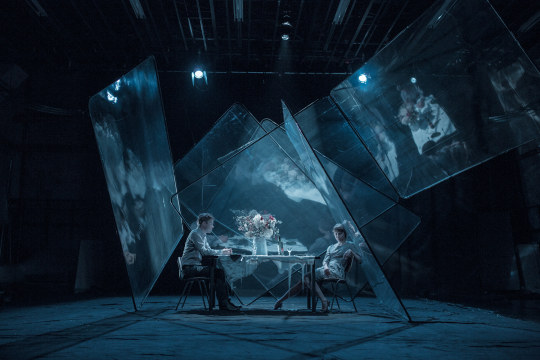
Where did your interest in historical stage magic come from?
I read a lot about the history of magic. I’m really into like, ‘What were the first tricks that magicians started to perform? What are the greatest illusions that no one does anymore?’. I love to read about those and a lot of my influences come from there. I’ll see some old trick that I’d like to try and maybe I’ll start to test it, ‘Could it work? What’s really the secret there?’. Then quite often I’ll forget the original thing and just take some elements from it. So it may be that the theme, or the secret or a visual idea will develop into something completely different.
For instance in Lähtö there’s this trick with mirrors. Normally in that trick, when it was originally performed, you don’t really see the mirror, it’s hidden, so that’s kind of the secret, but what we’ve done is just the opposite. Originally we had just one giant mirror, but to make things more interesting we decided to spit it into several smaller ones. We’ve placed the mirrors so that they are visible for everyone and we manipulate and levitate and move them round the stage. It’s completely different than the original but there is still the foundation it came from, the idea of testing the old illusion but developing it.
You mentioned going to youth circus, have you got any circus skills?
I practised juggling for many years; that’s something I like to do, but I’ve never performed as a juggler. I’ve done some shows together with jugglers and I really enjoy seeing jugging and also thinking about it, but I’m not so skilled as a juggler that I’d like to perform as juggler. In some of my previous shows I’ve used magic and juggling and perhaps at some point I’ll do more of that.
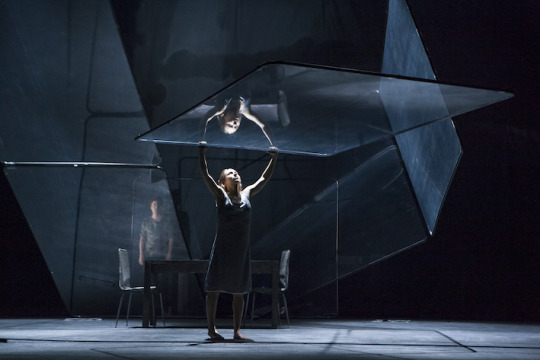
And you’re also an artist. Did you study art?
Yes, I have a masters degree in Fine Arts. I went to the Academy of Fine Arts in Helsinki in the department of Time and Space. It means it’s time-based arts, like performance and film and also spatial things, like installations and stuff like that. I studied there, and so I’ve been working as a visual artist as well.
And you’ve had exhibitors all over the place!
Yes, it’s true. For me, they’re pretty close to each other, actually. In the performances I do in theatres I consider the lights, the video projections and set decorations and everything that is on the stage to be as important as the performers themselves. So for me, it’s like a work of art. Everything has to be connected together, everything has to work at the same time. So basically, the exhibitions I do are pretty much the same, but one difference is that usually there are no live performers.
The biggest difference between an exhibition in a gallery and a show in a theatre is the way that I can manipulate time. In a theatre the audience comes and will sit there for an hour and normally they don’t go away in-between, so I can have a linear timeline. But in an exhibition people come and can spend maybe five minutes, maybe an hour, you don’t know and you cannot control that, so it’s a really subtly different way of how you can control the audience. I think that’s really interesting because it makes how you have to see the linearity of the work so different.
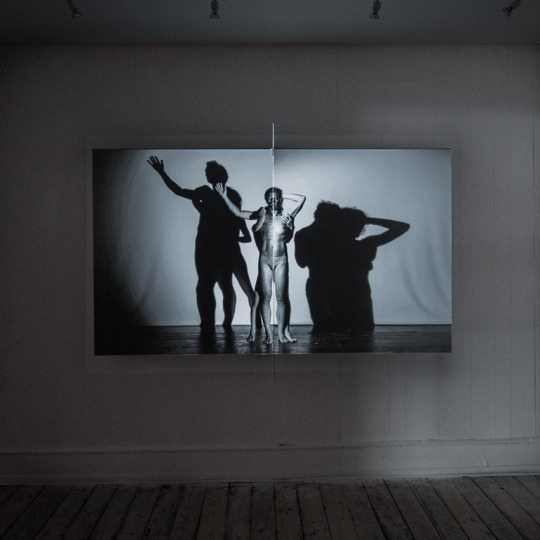
When was WHS’ first show?
Our first premiere was in 2002. We did something like five shows together, the last one in 2008. Since then we’ve been working separately; we run the theatre, where I am at the moment, but for the past ten years it’s been more like two companies or like a collective/producing facility. We also produce other artists and circus performances so it has grown into many companies under one name.
Yes, we interviewed the artist Salla Hakanpää about Dive.
Does your association with circus artists come from youth circus?
I’m a magician and did a lot of juggling, so I started to work with jugglers and the first shows I did were pretty much circus kind of shows, but they also used a lot of projections. For me the development has been that I started with more common circus elements but bit by bit it’s developed more into visual theatre or theatrical things that I’m interested in. I still feel that the circus is somehow there in the background. I still enjoy seeing tricks and I like elements of the realness of circus.
Tell us about Vera Selene. Is she a circus performer?
No, she’a dancer and an actress. I started to work with her on Lähtö and since then we’ve done Cutting Edge; she also performs in that. She’s a really great dancer and I love the way she performs onstage.
The illusions in Cutting Edge look really intriguing!
I really love the theme of that show. It’s curious, if you take maybe 100 of the most well-known magicians’ illusions that there are, like, sawing a woman in half, putting swords through a woman, cutting a head off somebody, putting spikes through somebody, it’s all super-violent things. It’s like the magic is full of these really, really violent tricks and for me the question was, ‘So as people, why do we want to see that kind of thing? Why is it fun for us to see somebody being sawn in half?’. That was the starting point of the show.
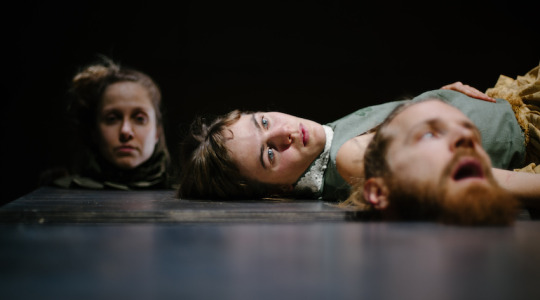
Also the sawing a woman in half wasn’t actually originally sawing a woman, but a small boy. It didn’t become really famous until they switched it to being a woman; then it became a huge hit. It tells us so much about how our society in Europe… how the European culture is built, that we actually want to see, especially women being sawn and tortured in whatever way. If you take the history of art you have these paintings where everybody has been decapitated and in reality, with the French Revolution with all the guillotines and such. Every country has its own horrible culture of cutting off heads and it started to interest me, the decapitation as a spectacle, because in most countries it was like a piece of cruel theatre. It still exists on the internet and people really watch it. So, what’s wrong with us?
With Lähtö, you perform, you’re the director, and you’ve designed the projections and the illusions. Can you reveal something about it?
Lähtö means ‘departure’ and it’s about this couple who have a sort of complex relationship. They are perhaps splitting apart or perhaps not, and it’s not so much about the story but about the atmosphere and the emotion of what they are going through at the moment. What we’re trying to do is have the exterior elements tell us about their interior or internal feelings. We’re not trying to act so much, it’s more about how, for instance, the curtains behind us can express the feelings we have inside. We want all the external elements to be expressive. It has a lot of elements using magic and a lot of visual things like projections and things like that.
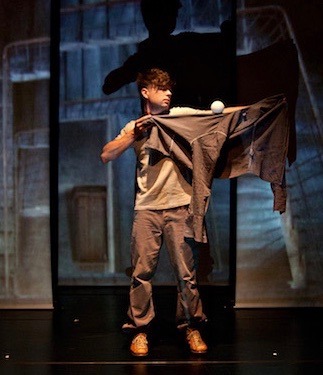
From the description in the programme, I was expecting some circus skills…
We don’t have acrobatics or juggling but the magic is the circus element that’s definitely there. There are a lot of tricks and then there’s the question of the definition; would you see magic as part of circus? I do, so I think that it’s not wrong to say it.
You do see magic in the circus…
The definition of circus is quite curious because so many people have different ideas about it but there’s also the definition of magic. That’s always a really good question for me because sometimes some people will say about some of the tricks I do in the show: “This is not magic.” And for others it is magic. So it’s like, ‘What is magic actually?’. Why isn’t an aeroplane magic because it’s flying or a refrigerator, because we don’t really know how it works? For me the circus is like… if we talk about traditional circus I don’t feel it is a tent with animals. Circus started much earlier; tenting circuses just arrived in the 1820s or something like that. I feel it goes way back into times where they had magicians and curiosities and all these kinds of things. That’s what I’m interested in; going way back.
Have you appeared in the Mime Festival before?
No, and I’ve never performed in London or anywhere in the UK before. I’ve been to London for two hours once when I had a fight connection, so it’s a really new world for me. I’m super excited about it and really curious to see how people in London will feel about our show.
vimeo
Kalle appears in Lähtö at the Platform Theatre in London from 10-13 January 2018 during the 41st London International Mime Festival.
For tickets to Lähtö, click here
Picture credits: Headshot, gallery shot and Cutting Edge heads, Kalle Nio; Lähtö, Tom Hakala; Waiting Room, Jeongah Ha
WHS on Facebook
Twitter: @MimeLondon @TheatrePlatform
Follow @TheWidowStanton on Twitter
Read our other interviews with Finnish artists: Hanna Moisala, Salla Hakanpää, Heidi Niemi and Saara Ahola
#kalle nio#lähtö#mime london#London International Mime Festival#whs#vera selene tegelman#interview#circus#magician#illusions#ville walo
3 notes
·
View notes